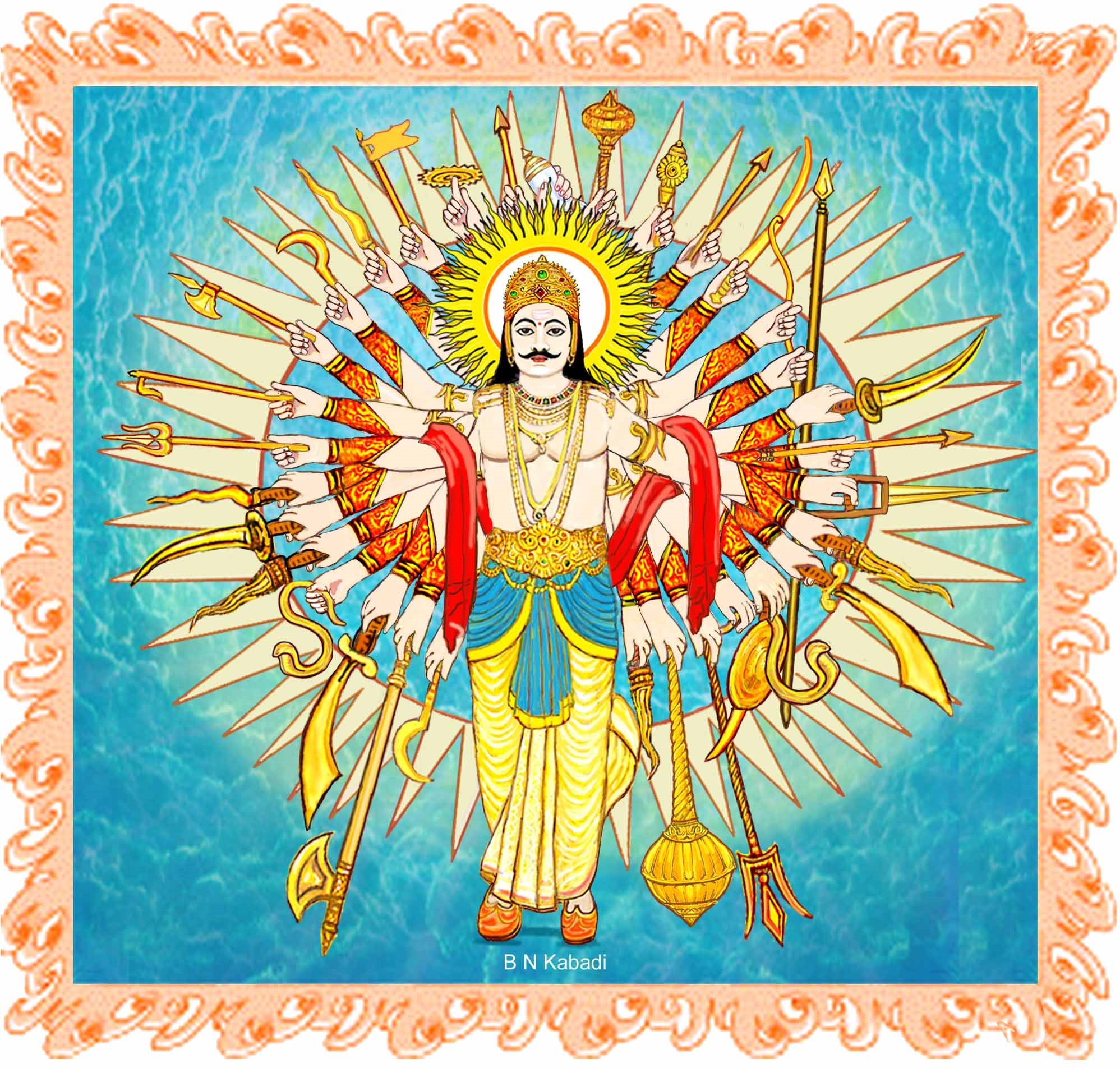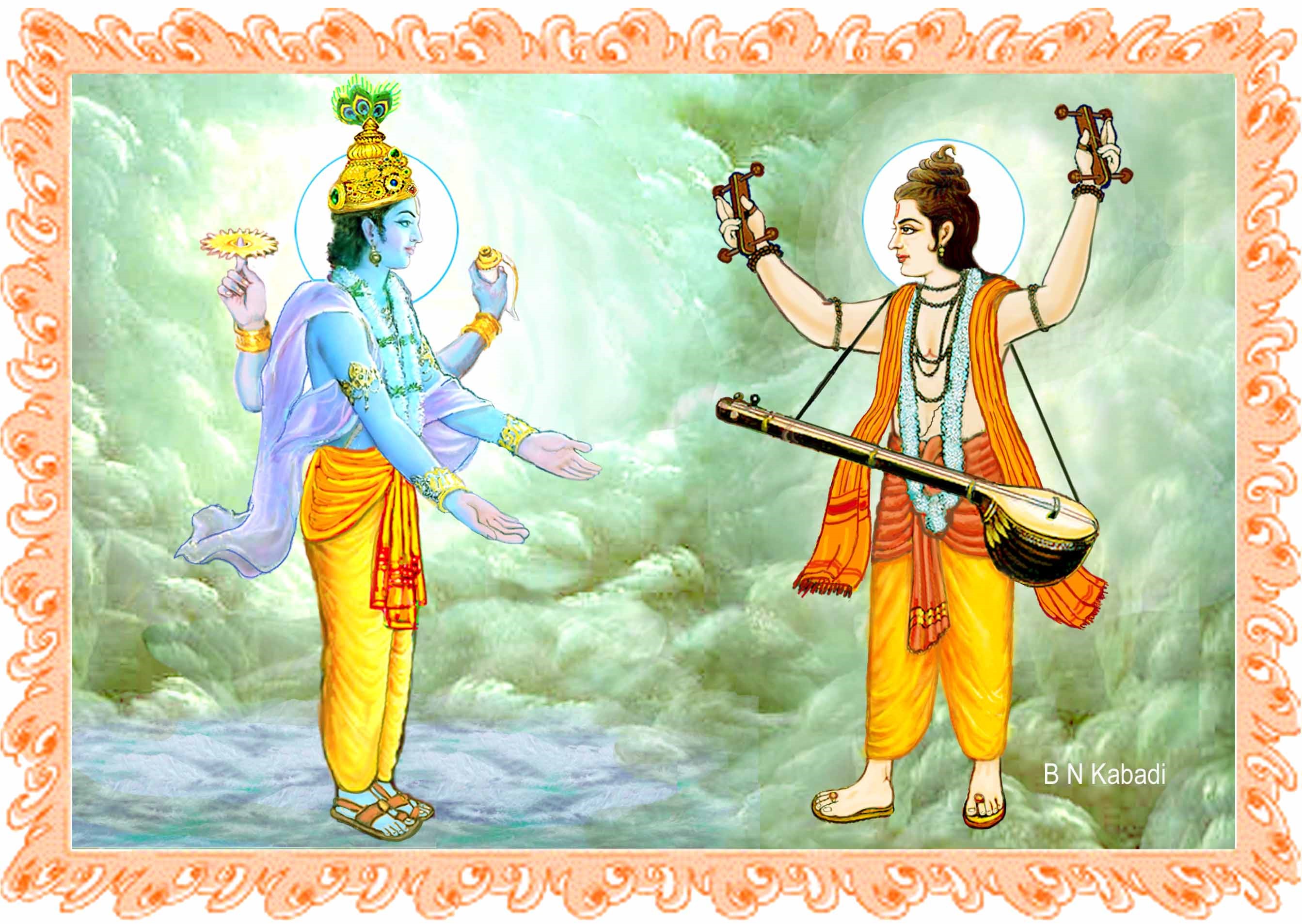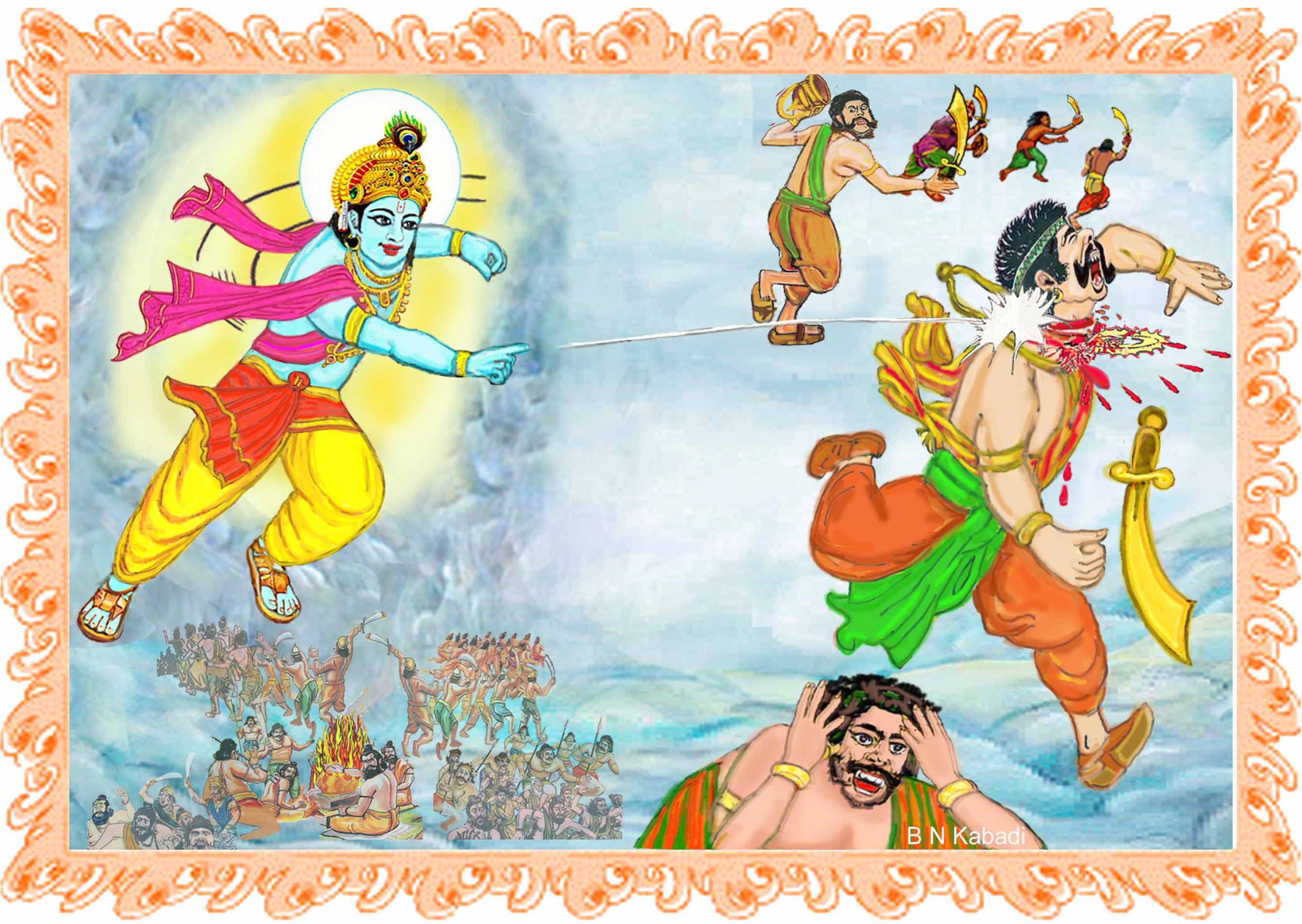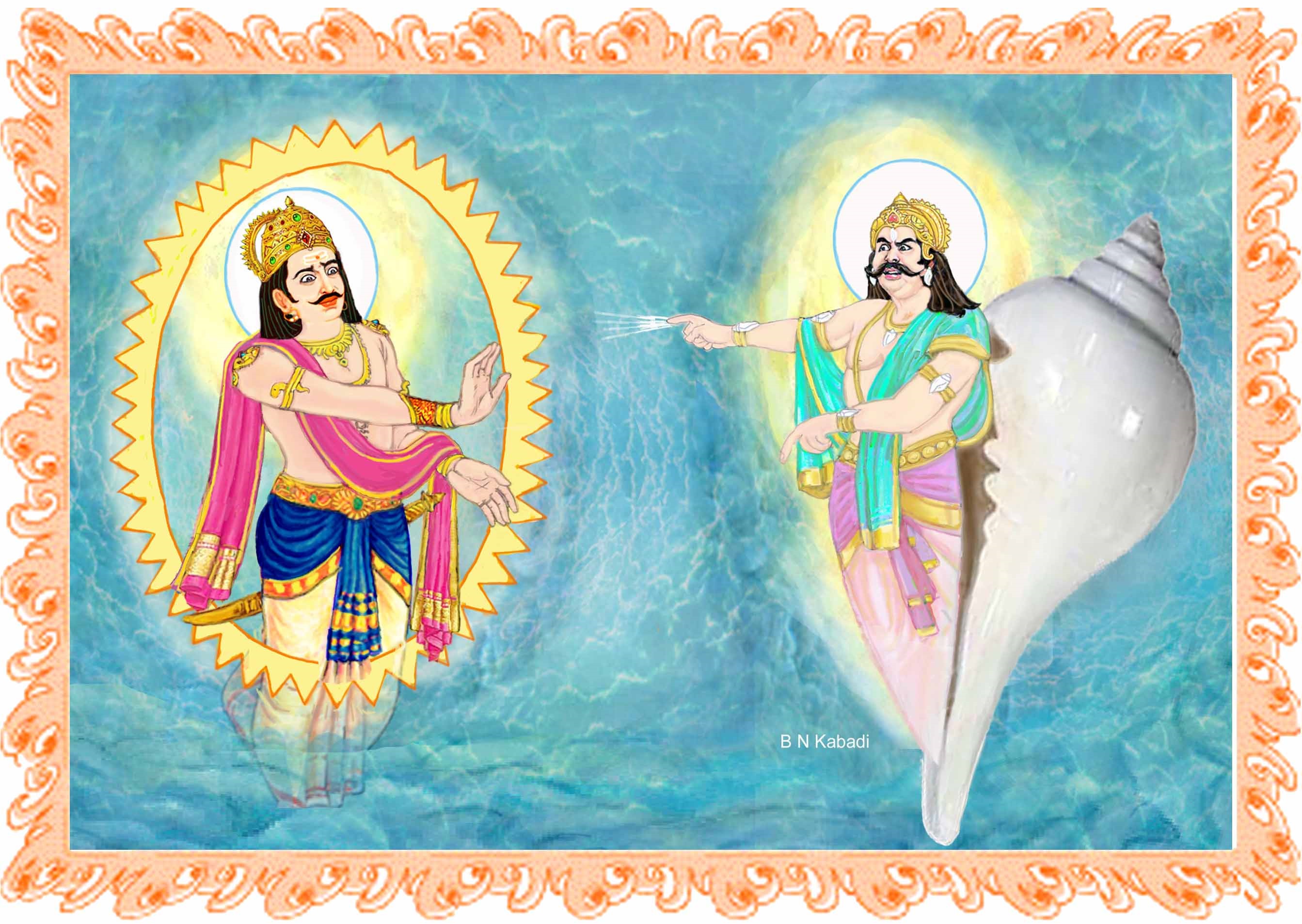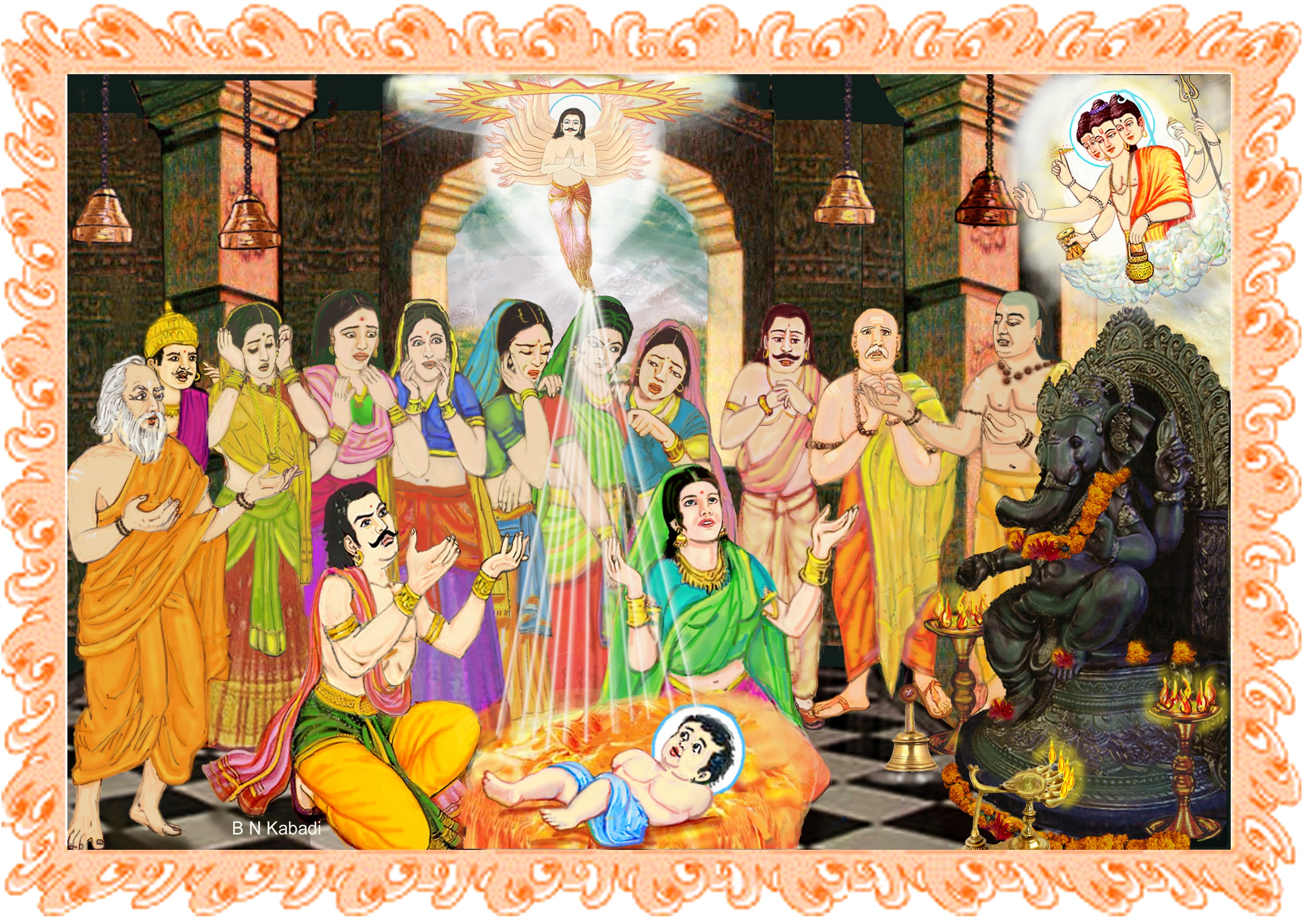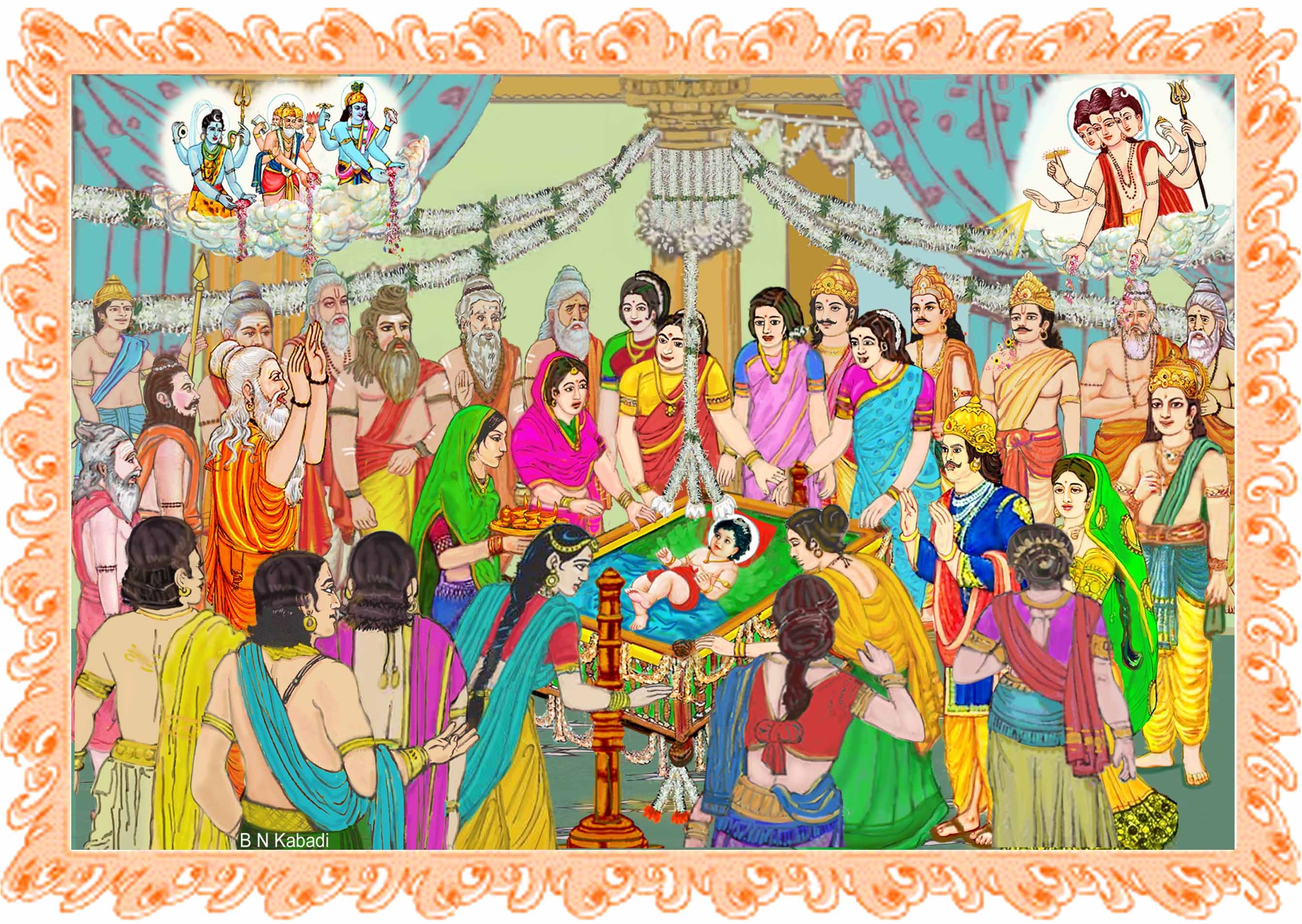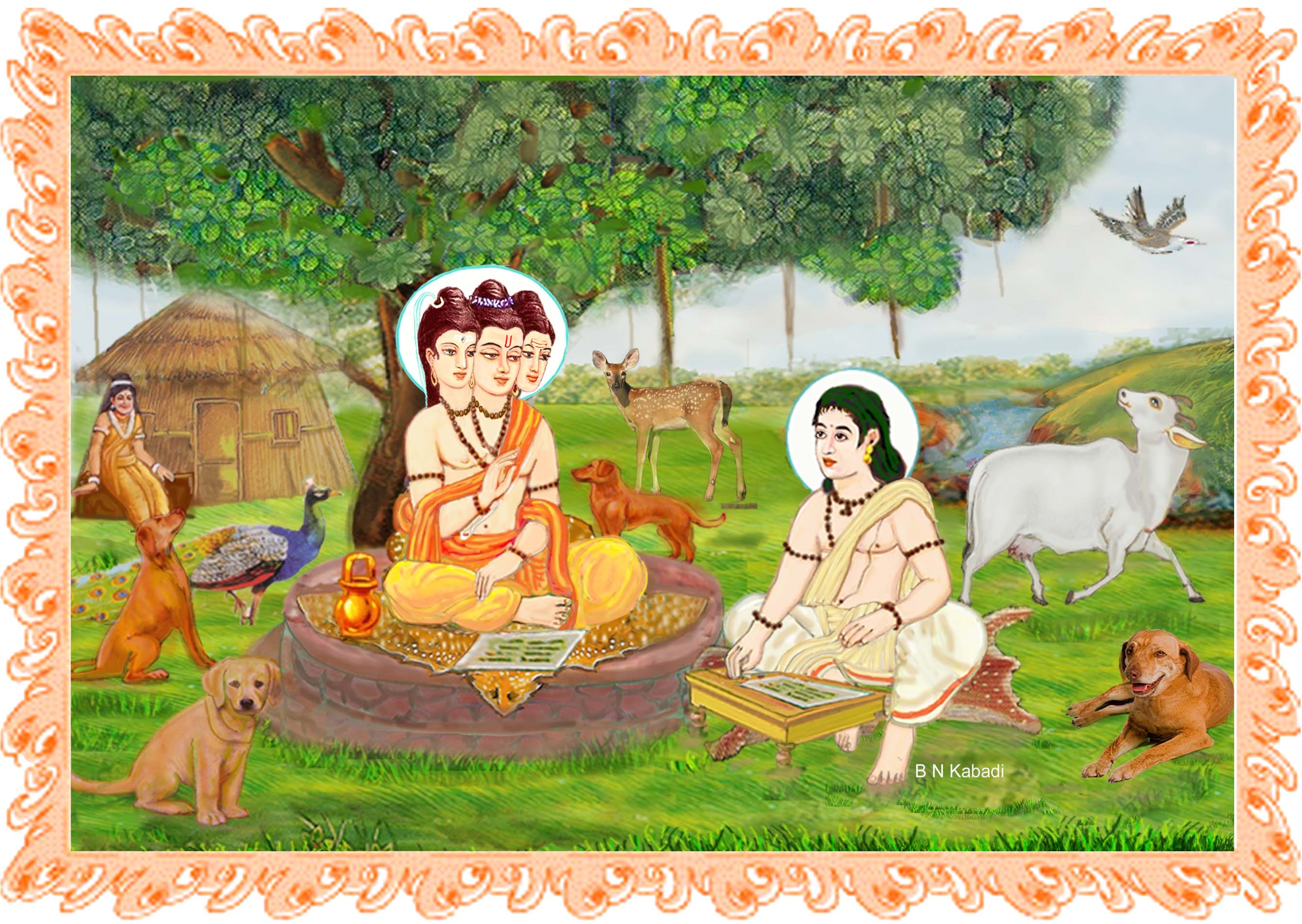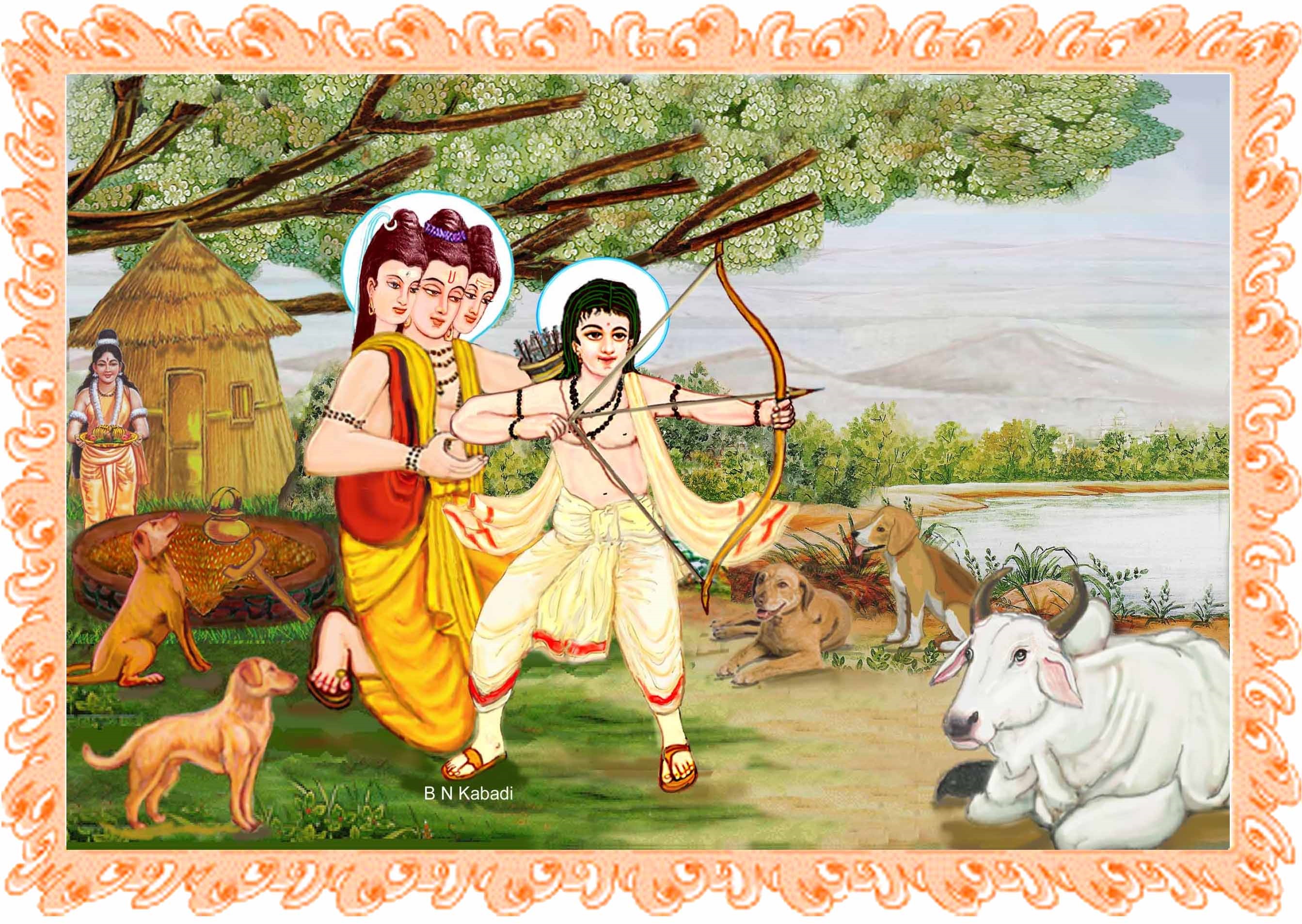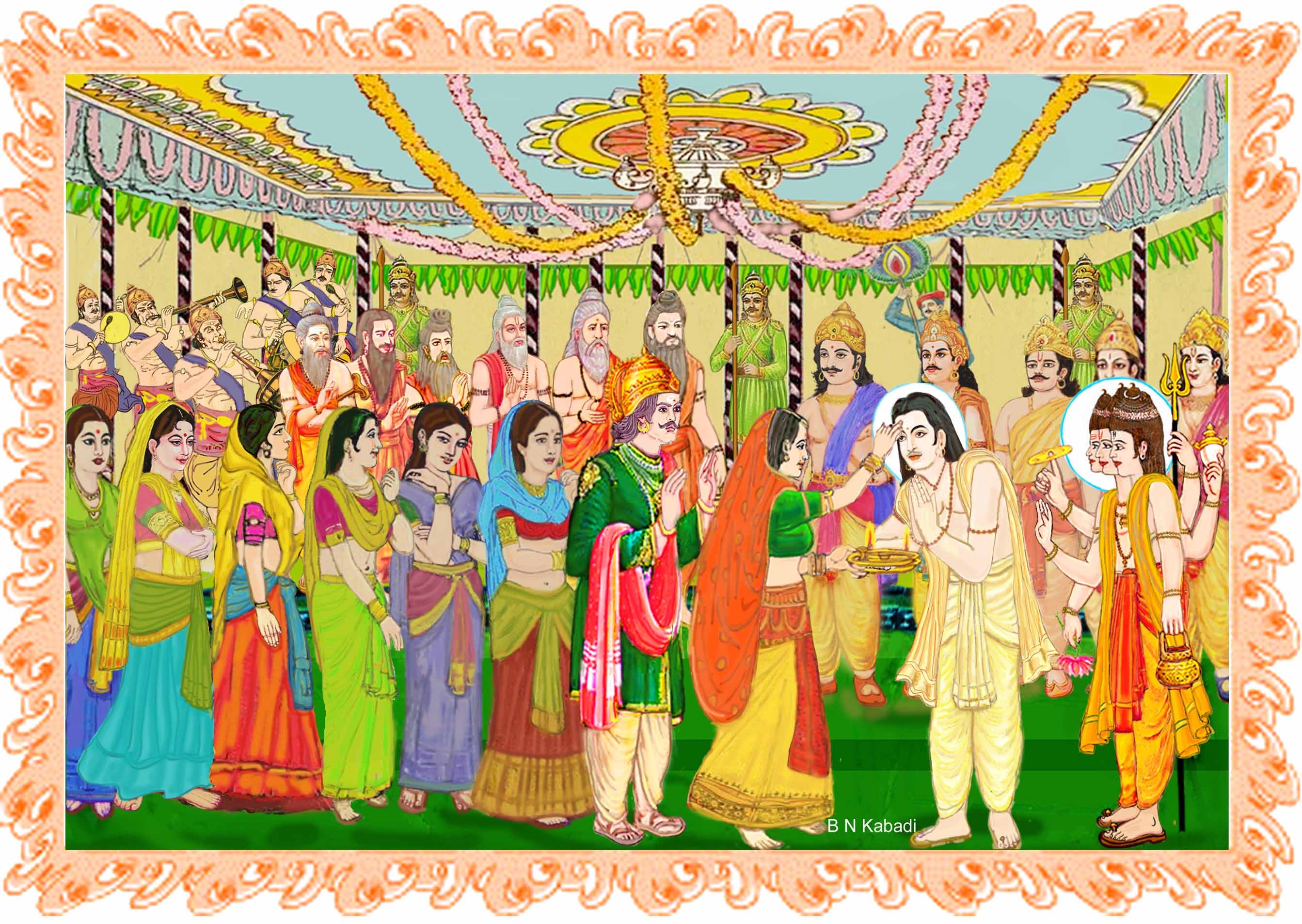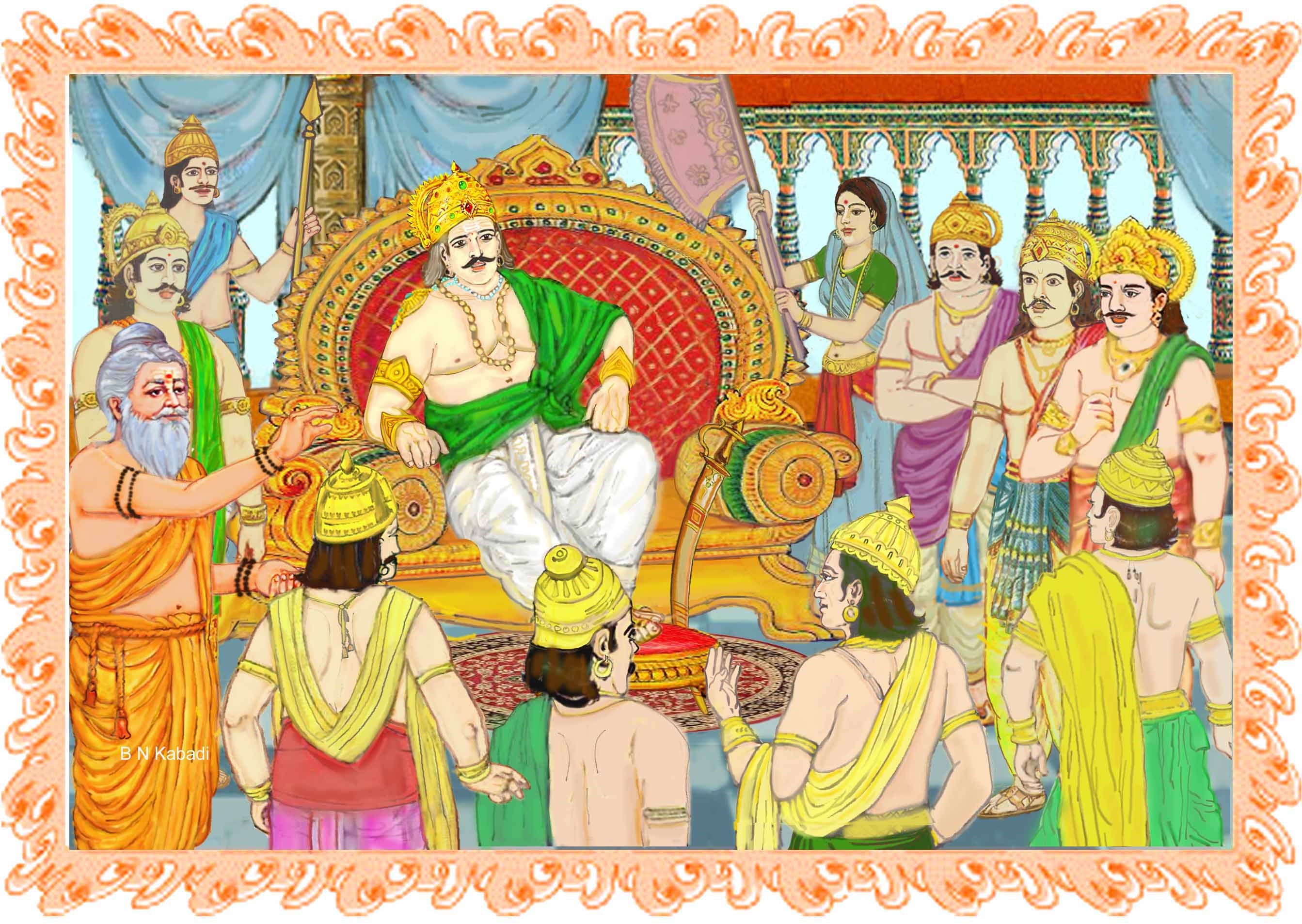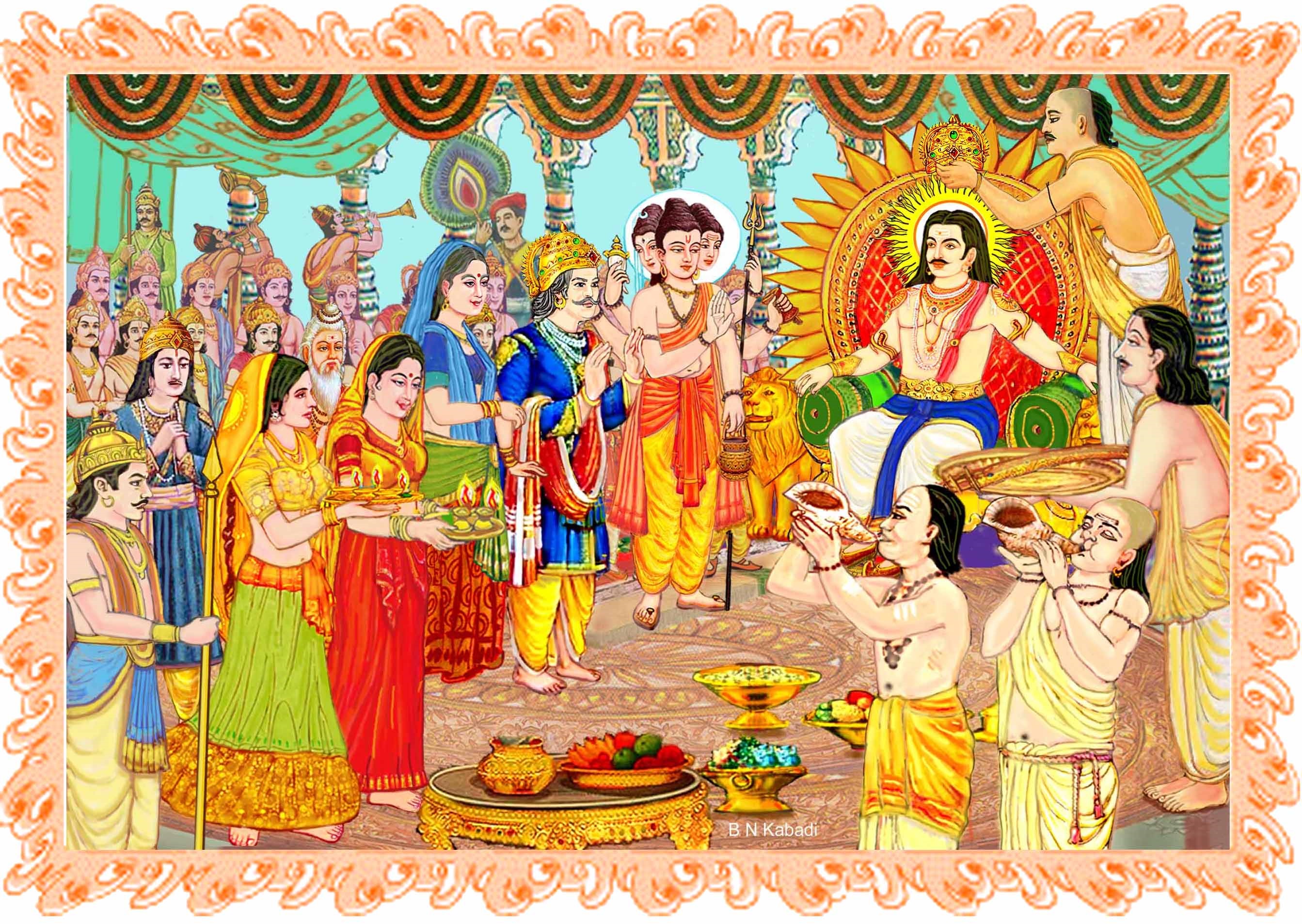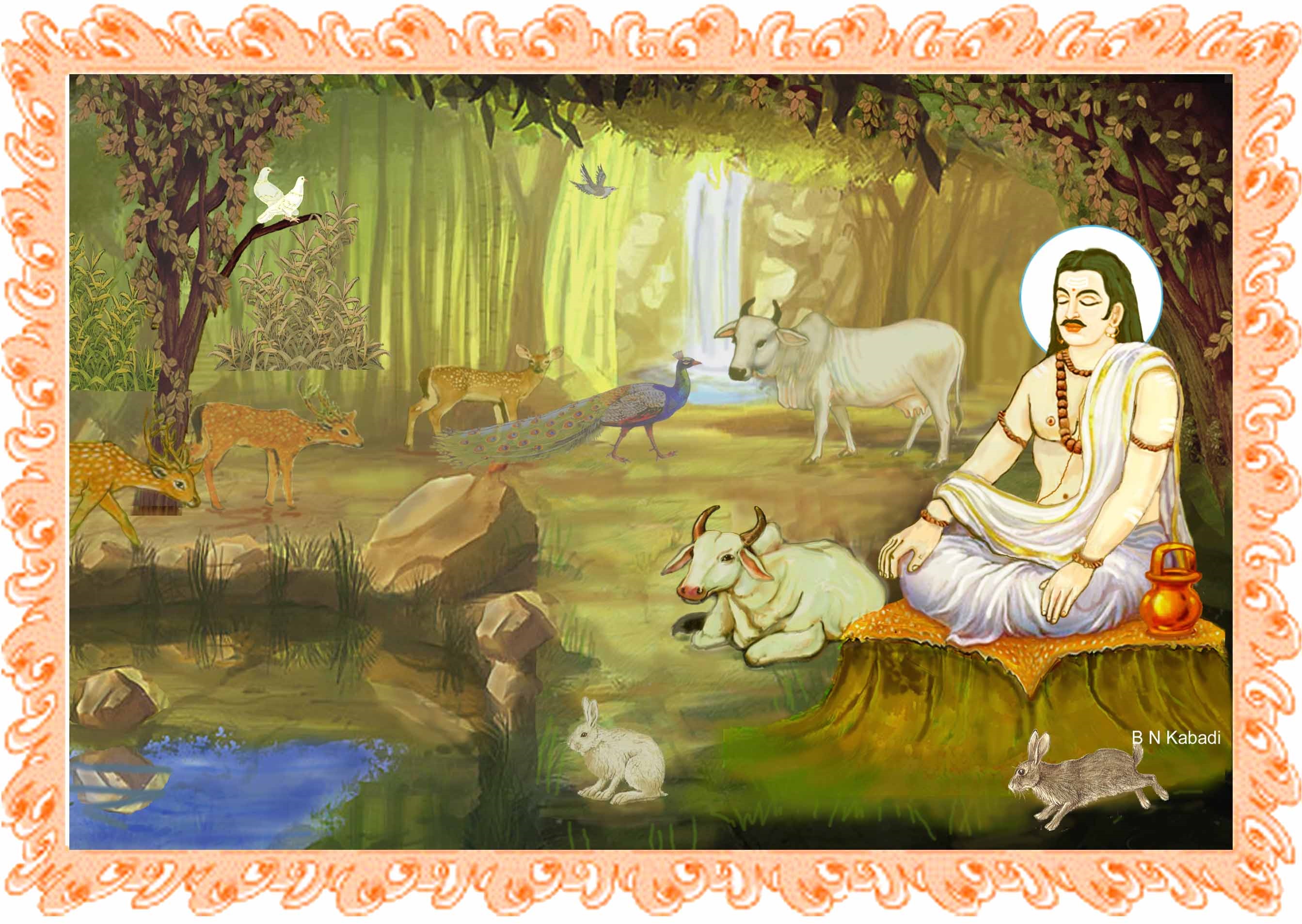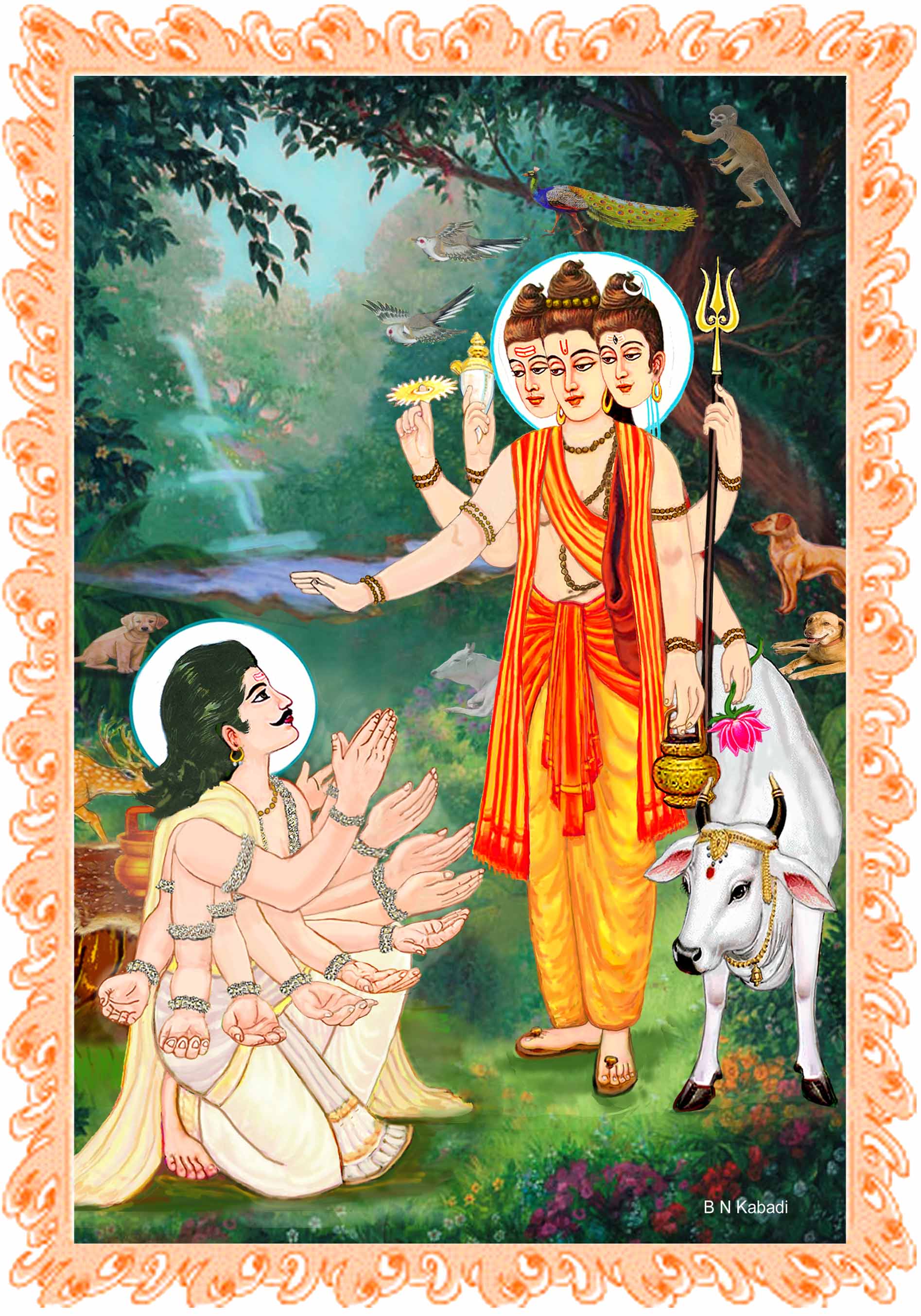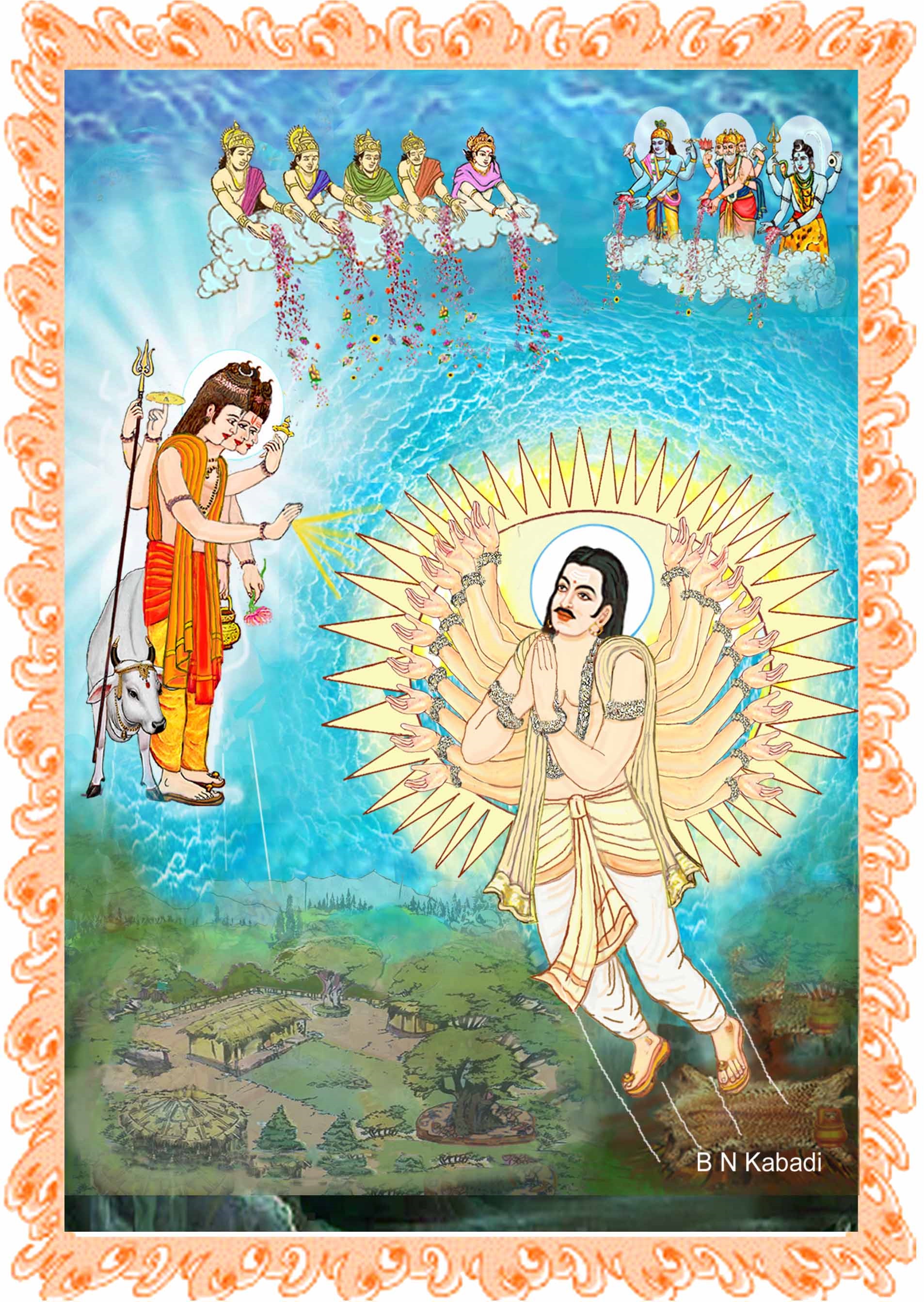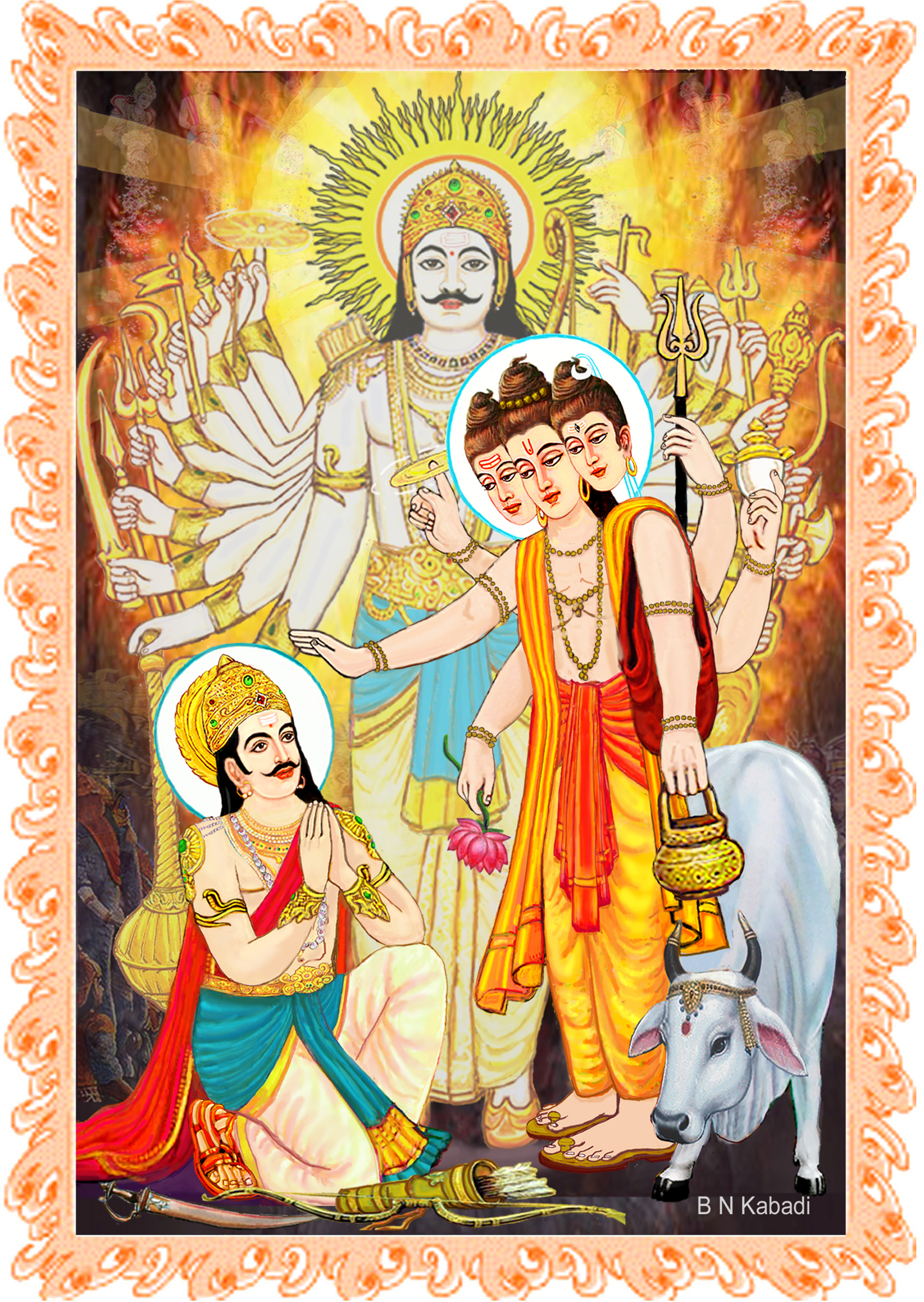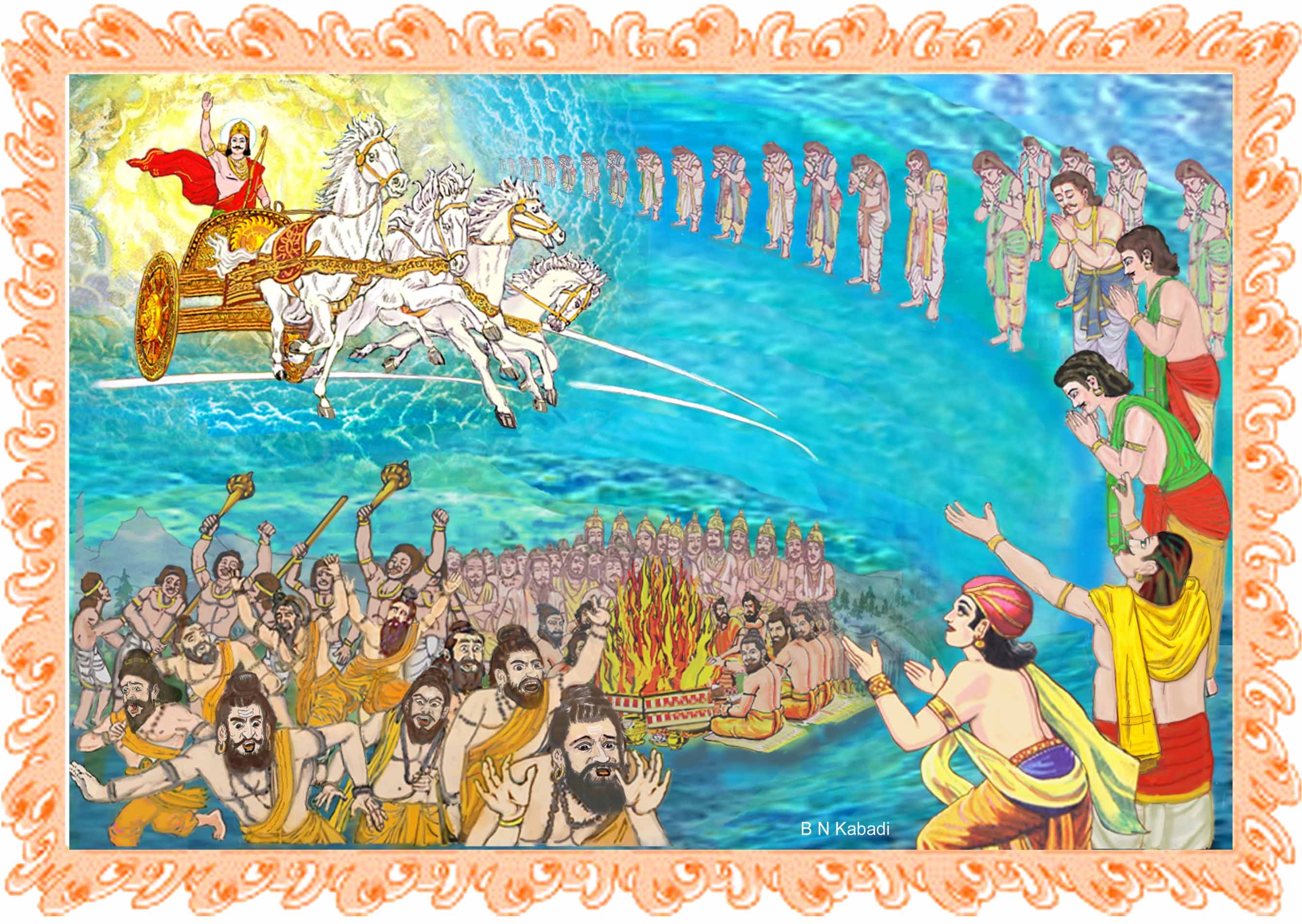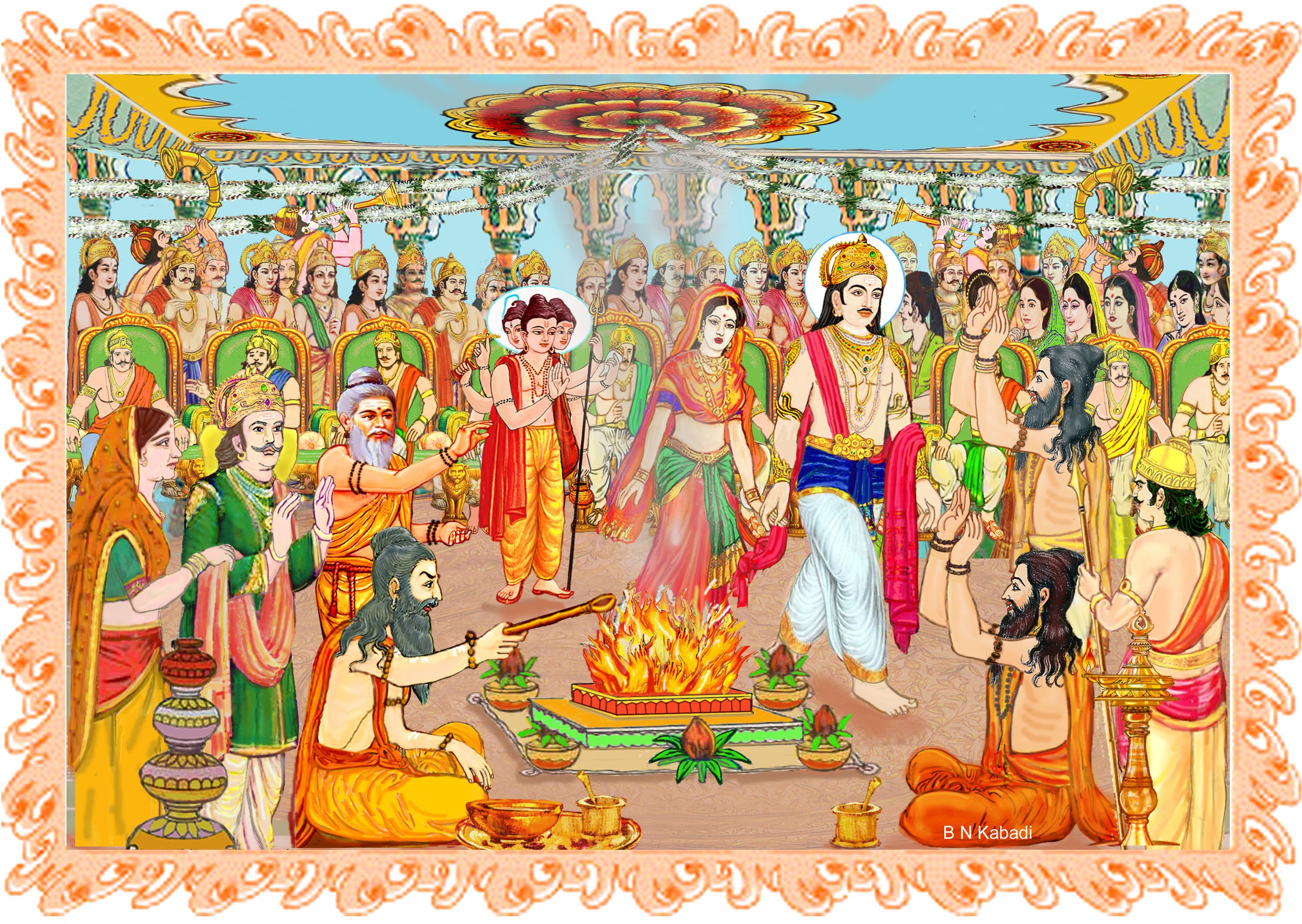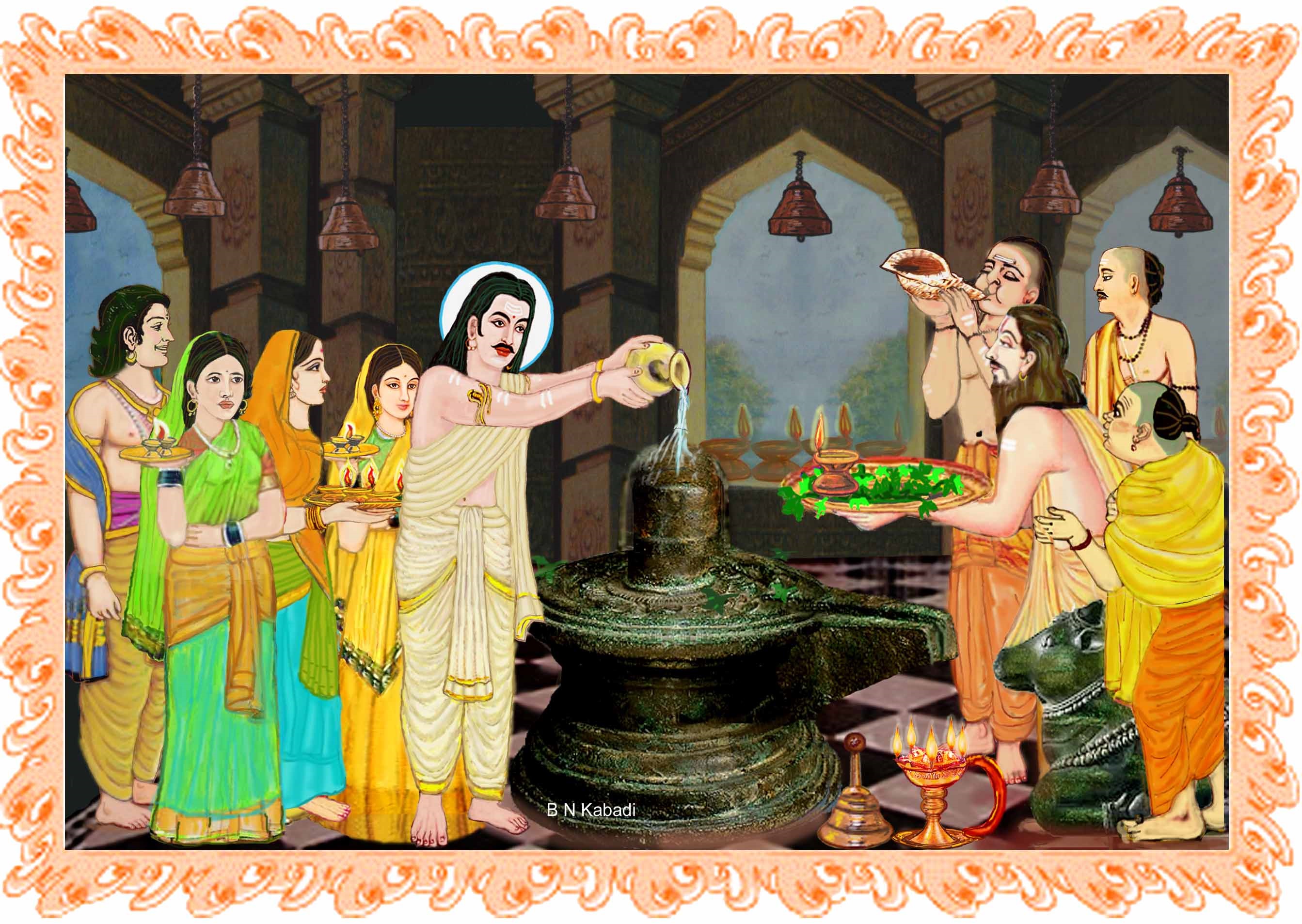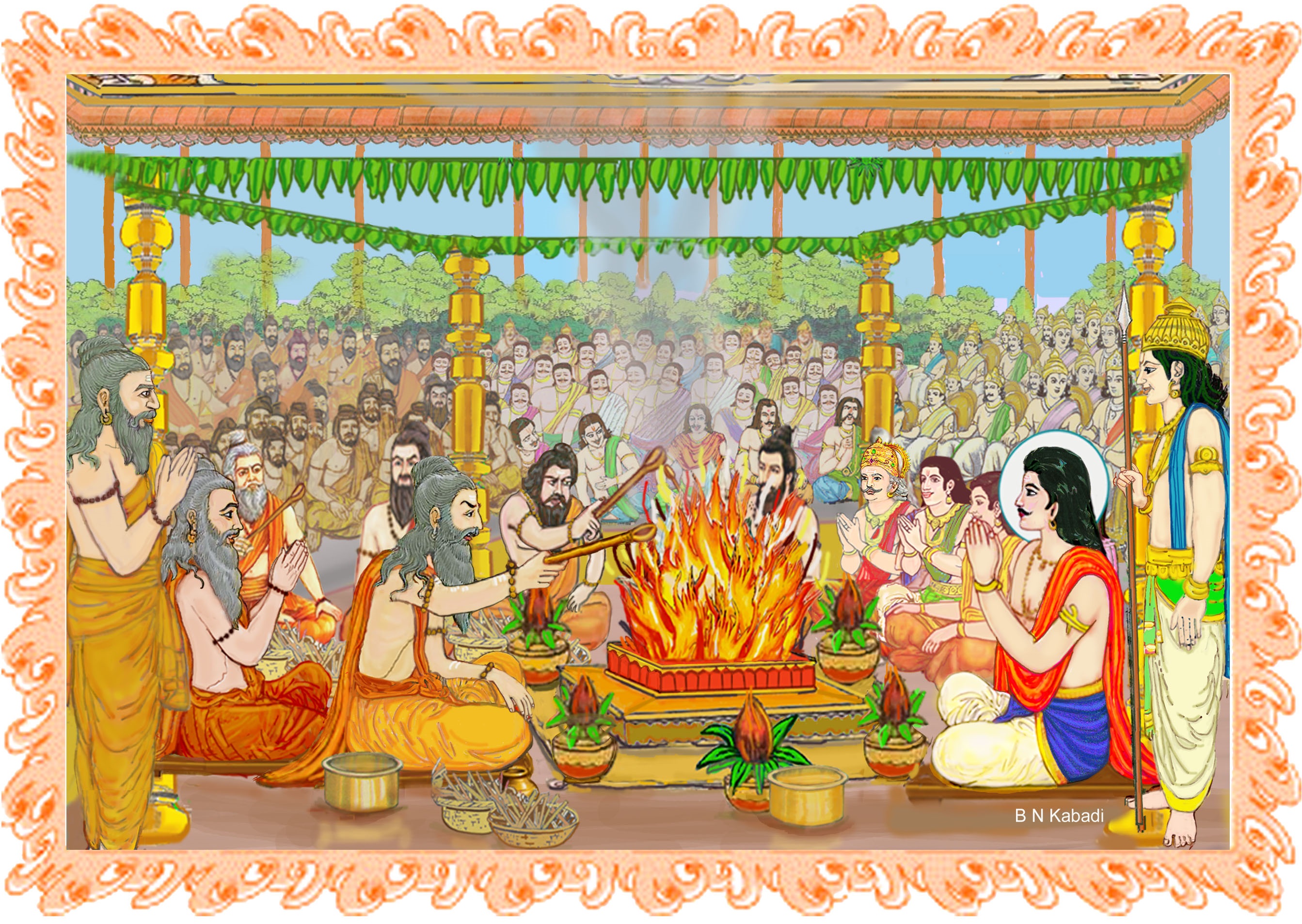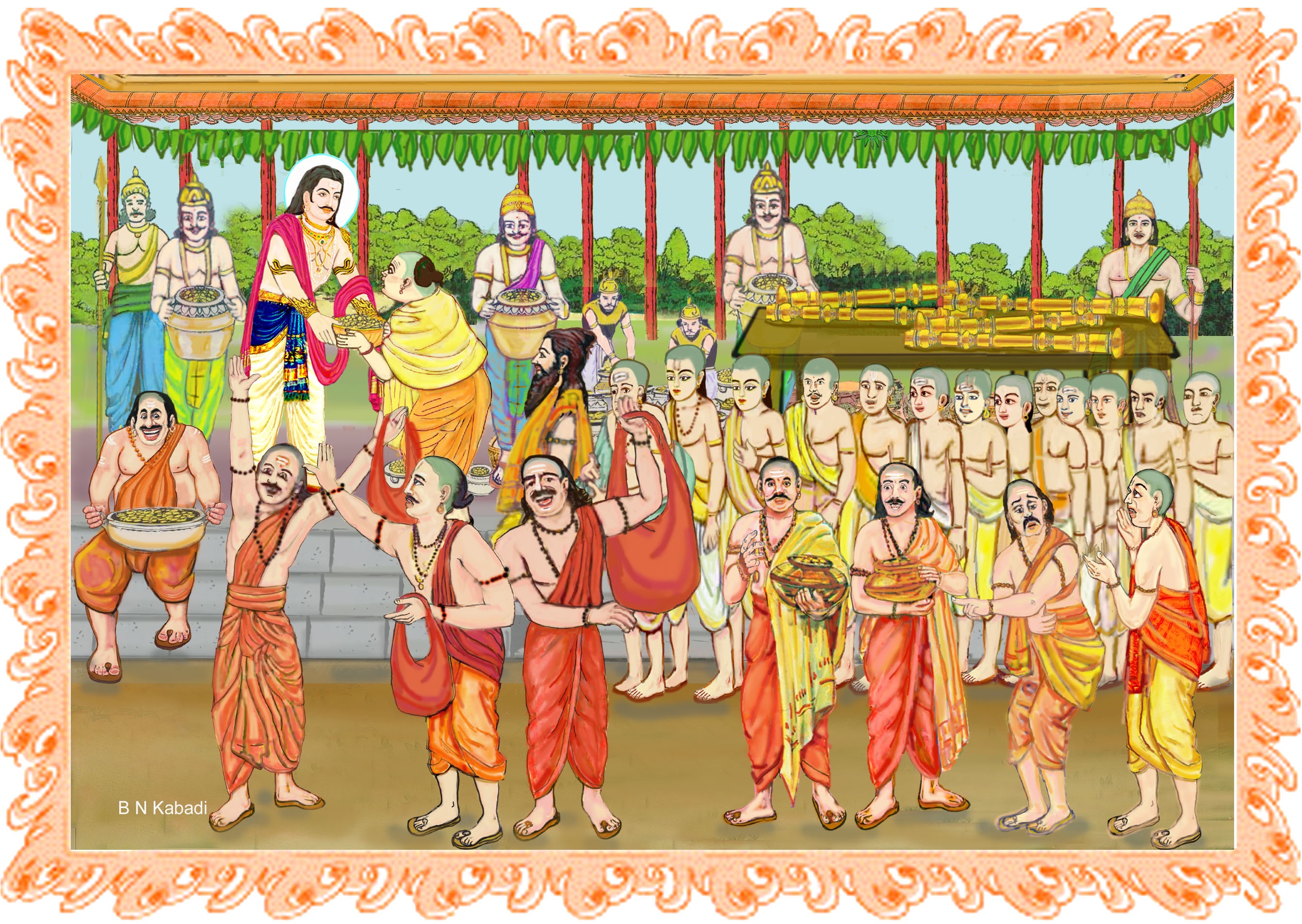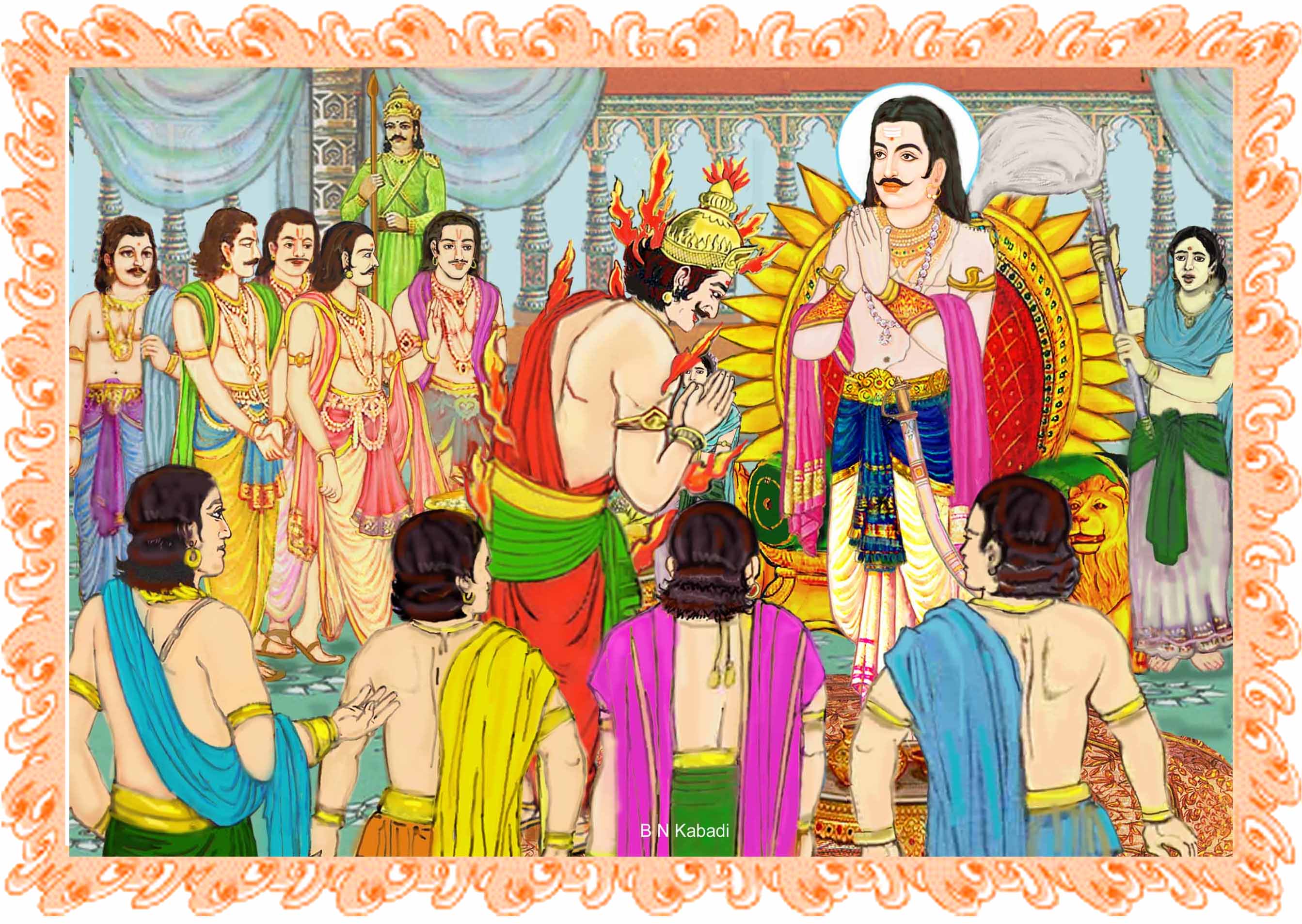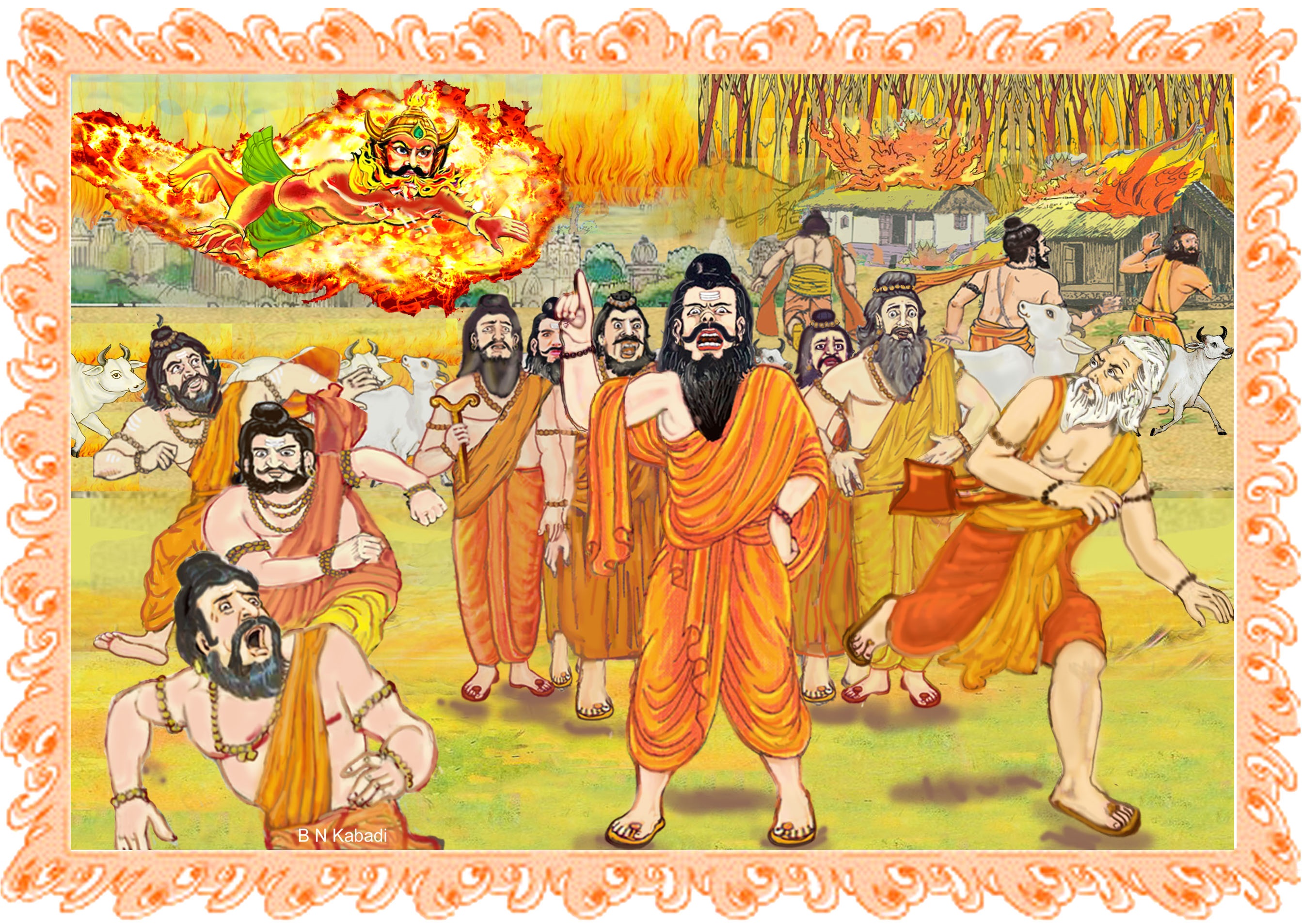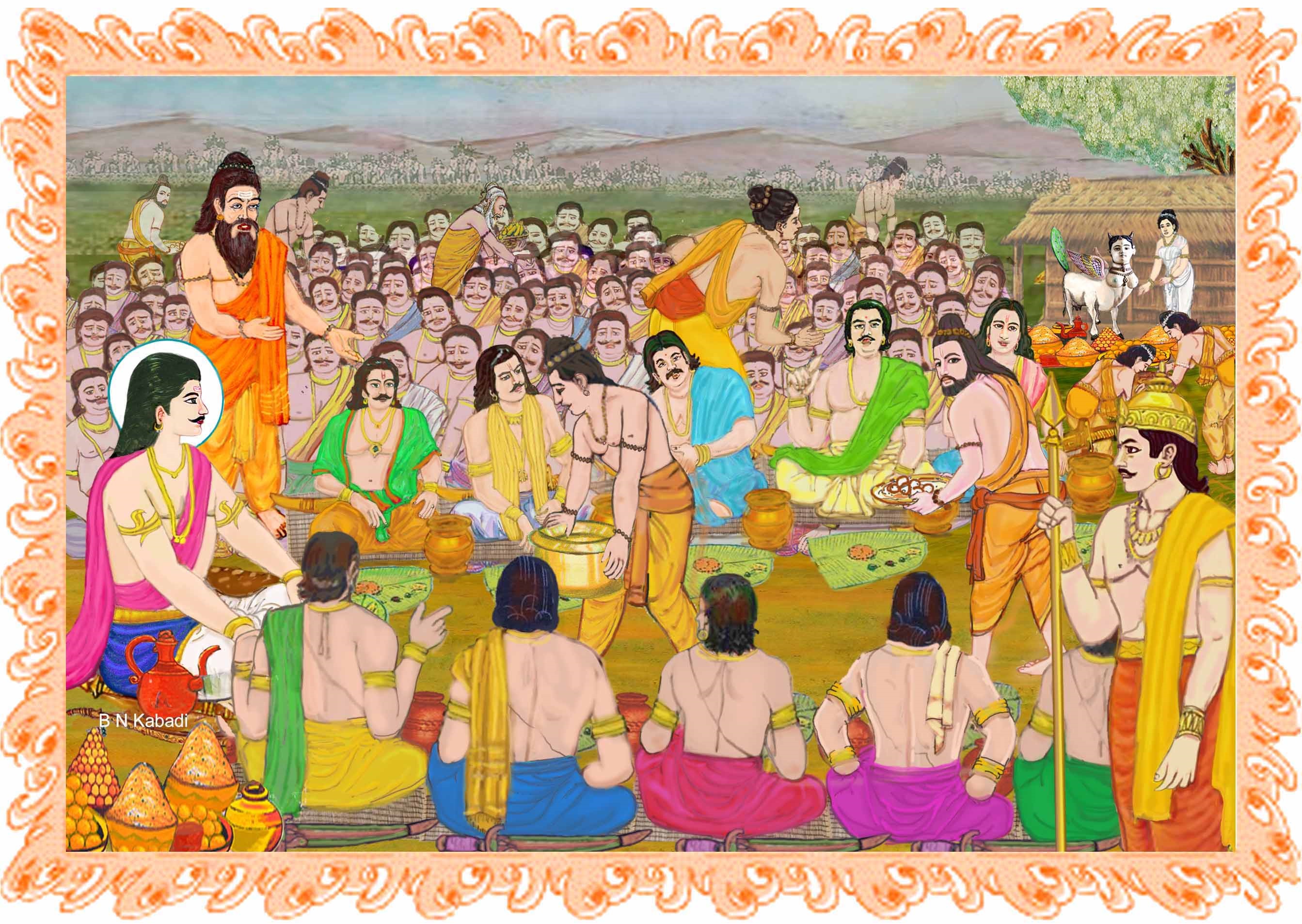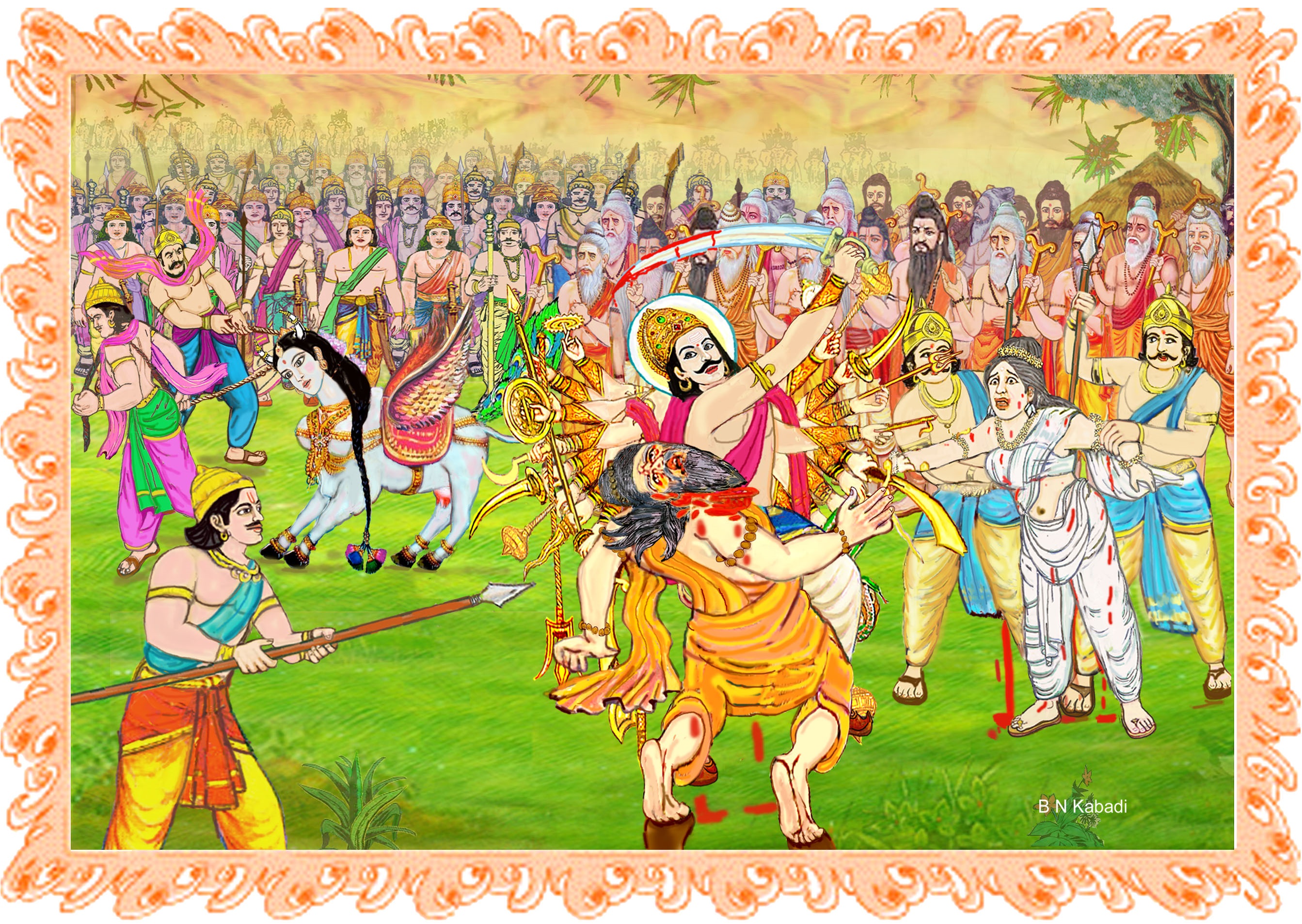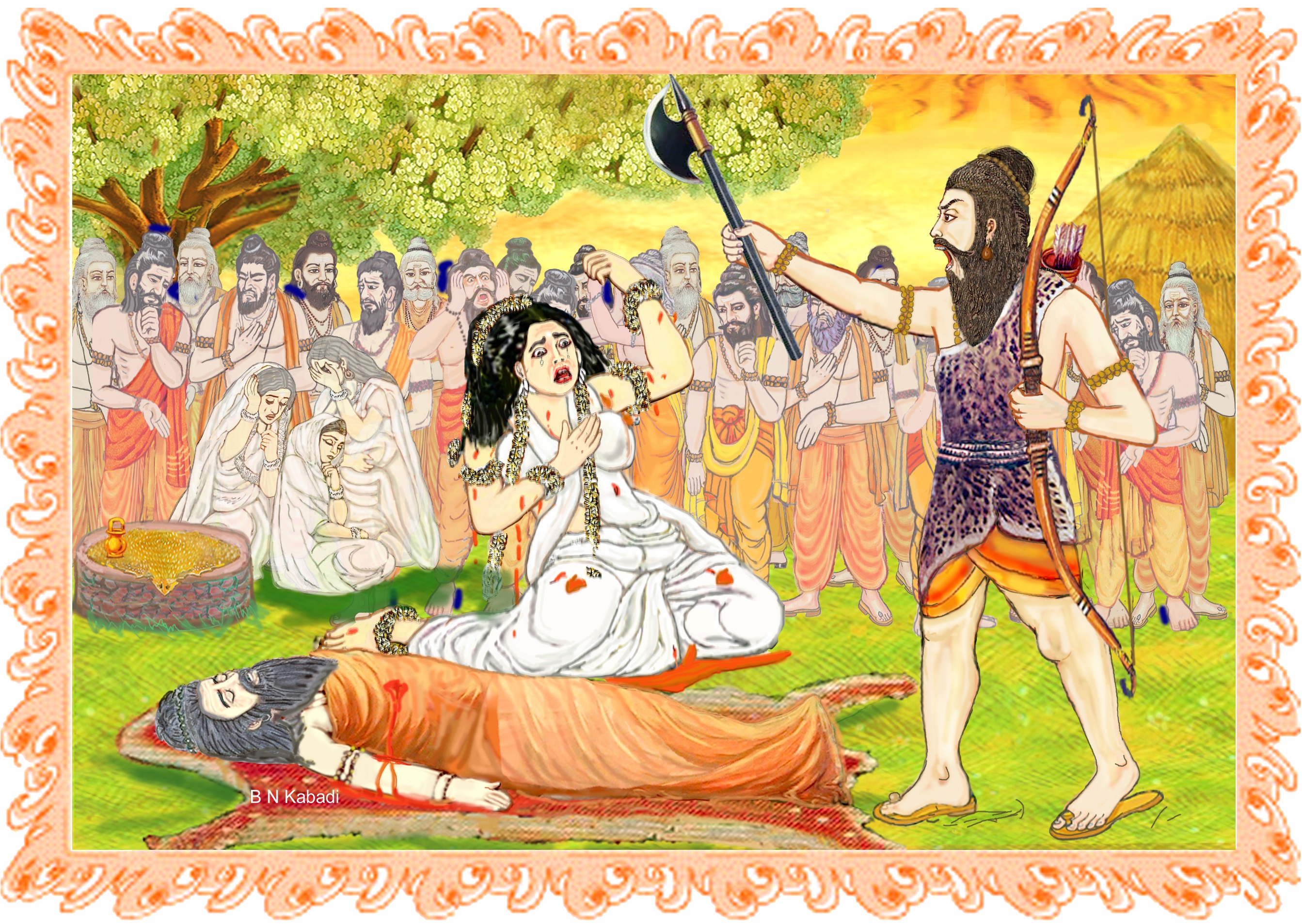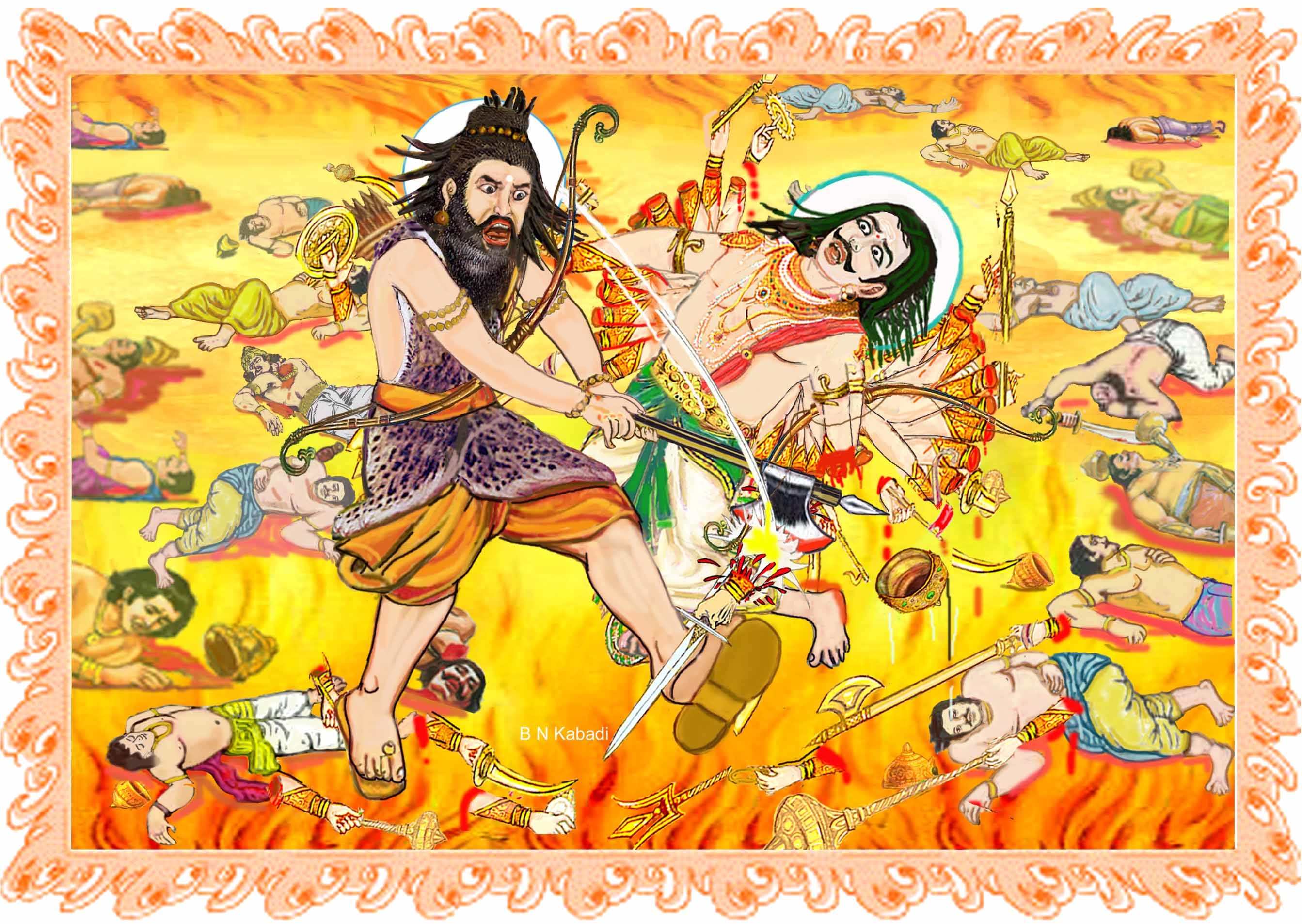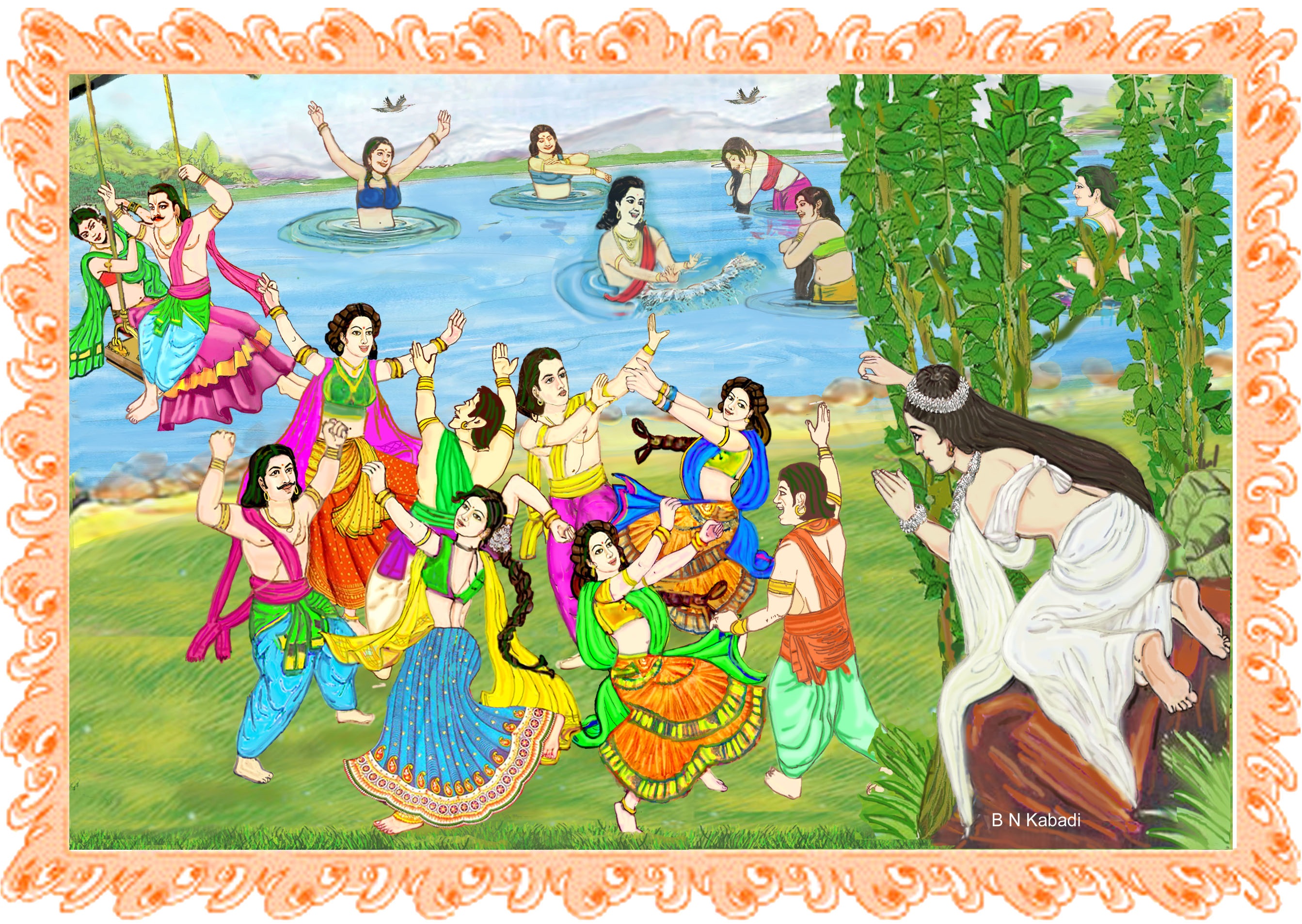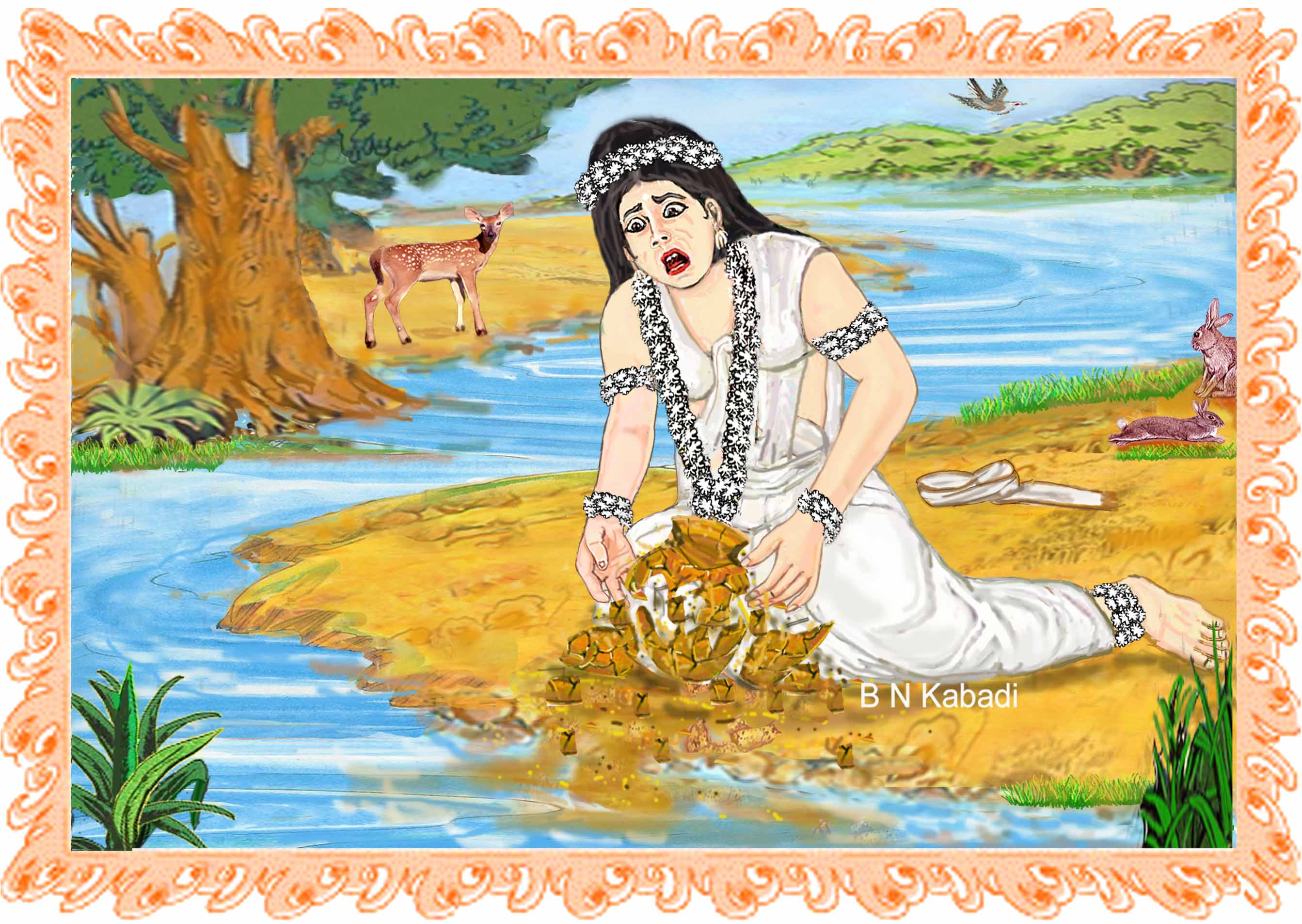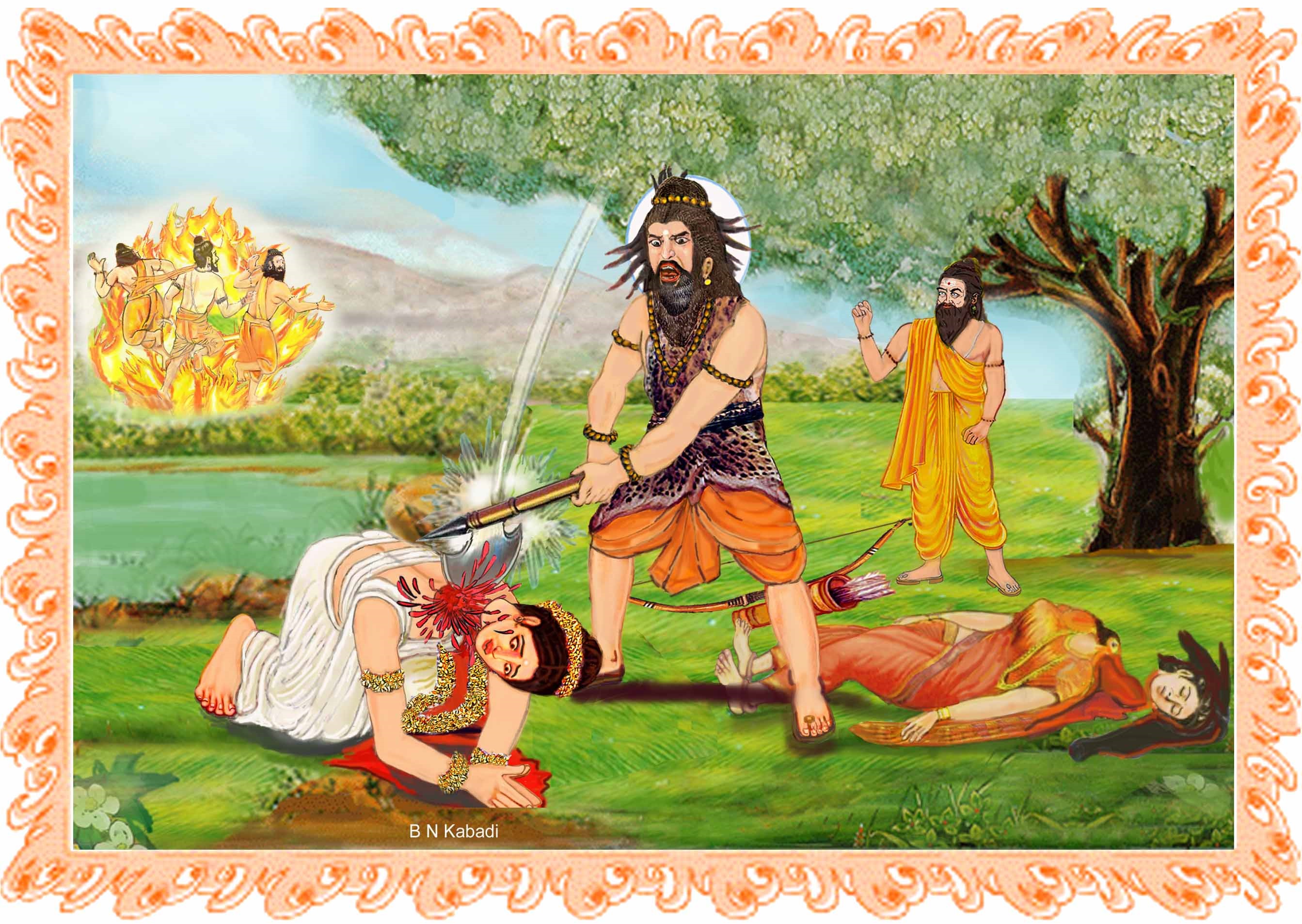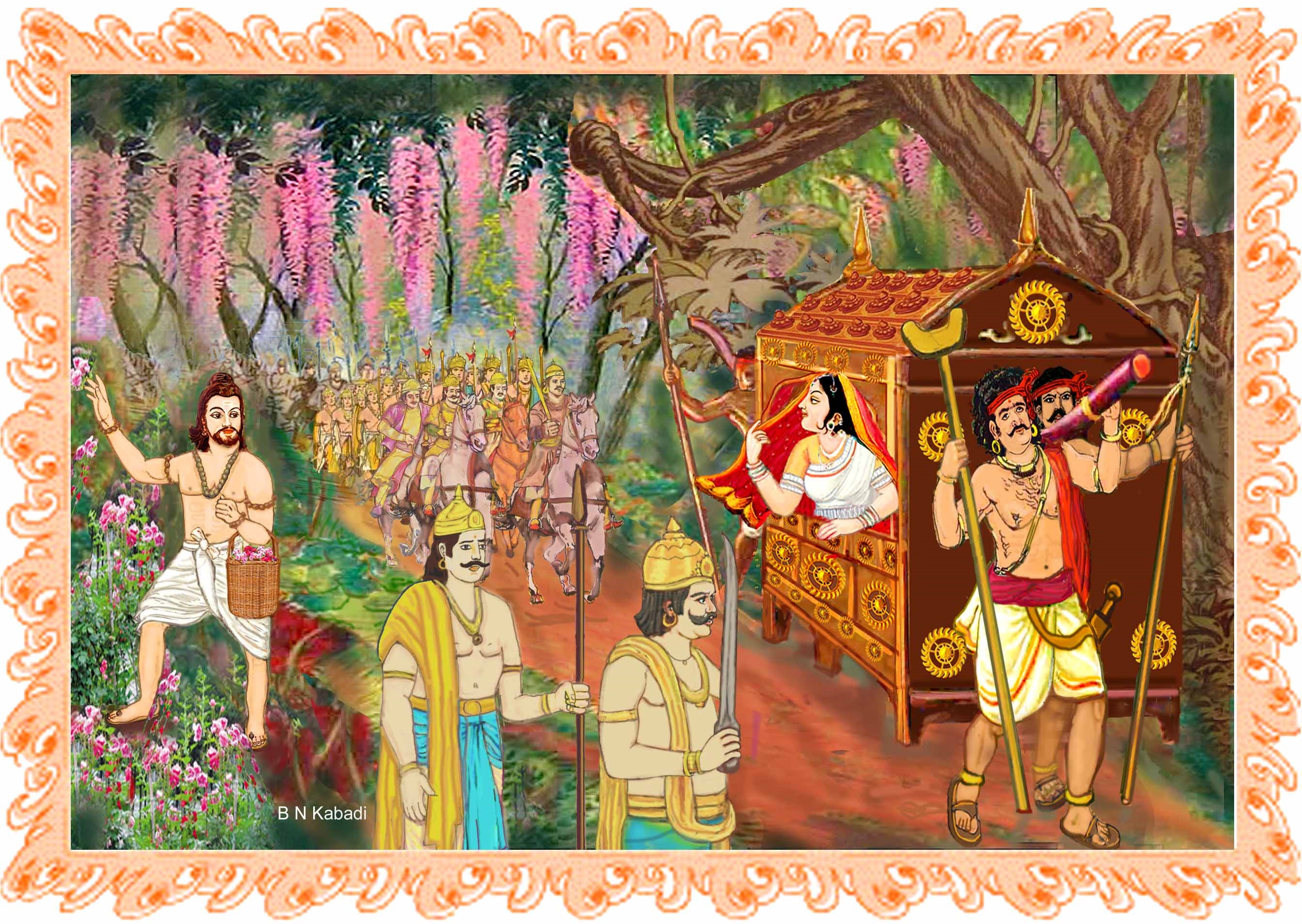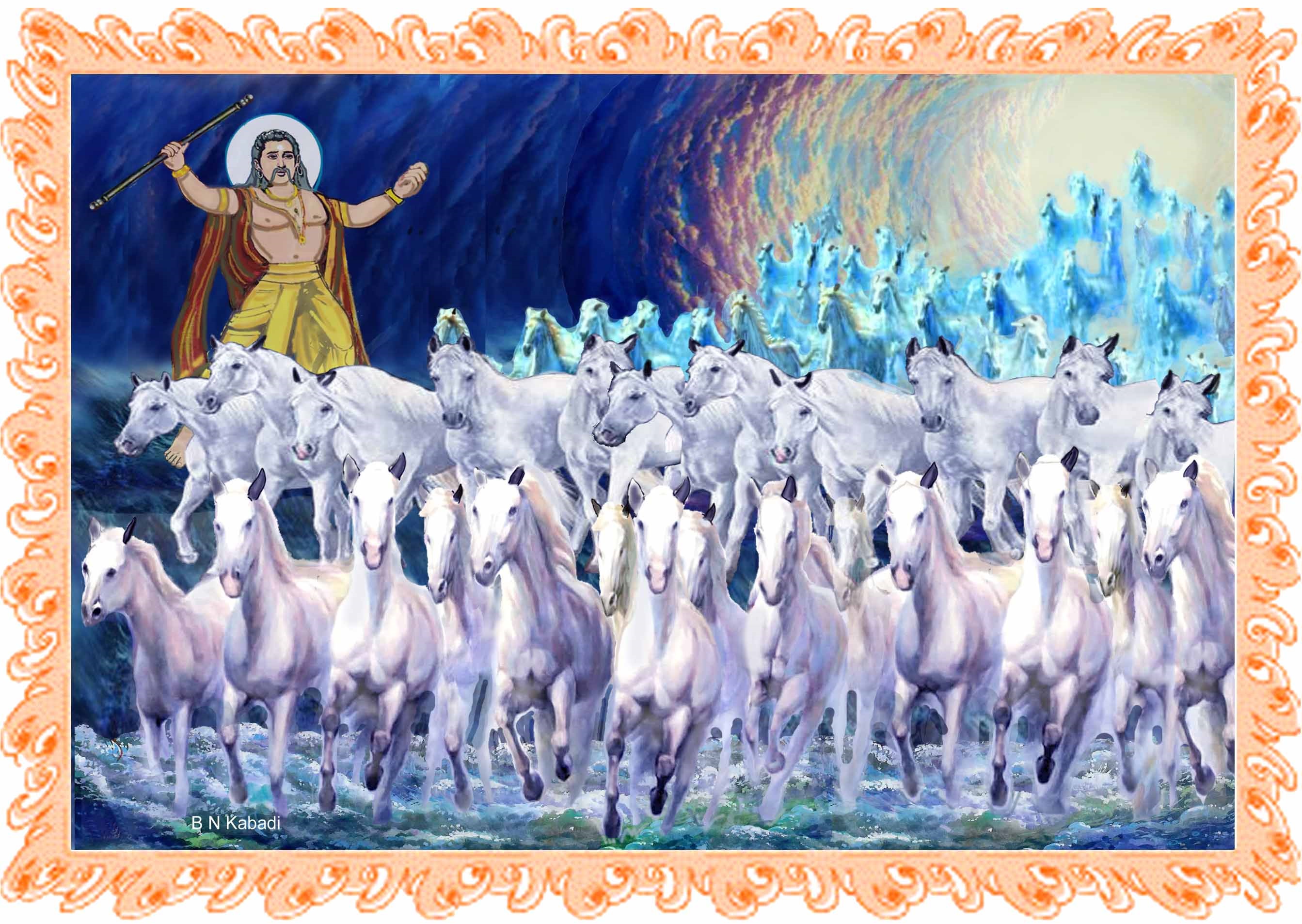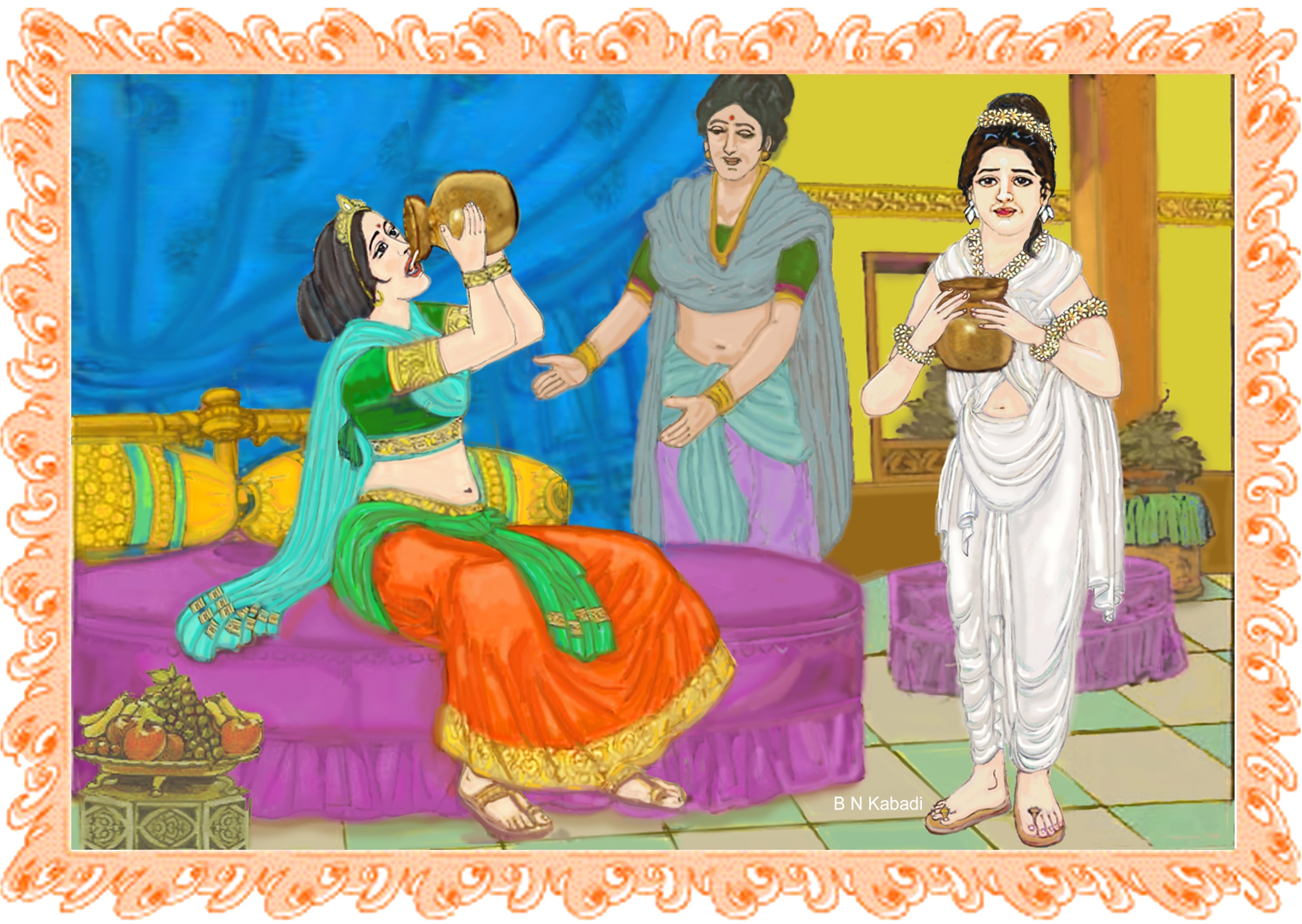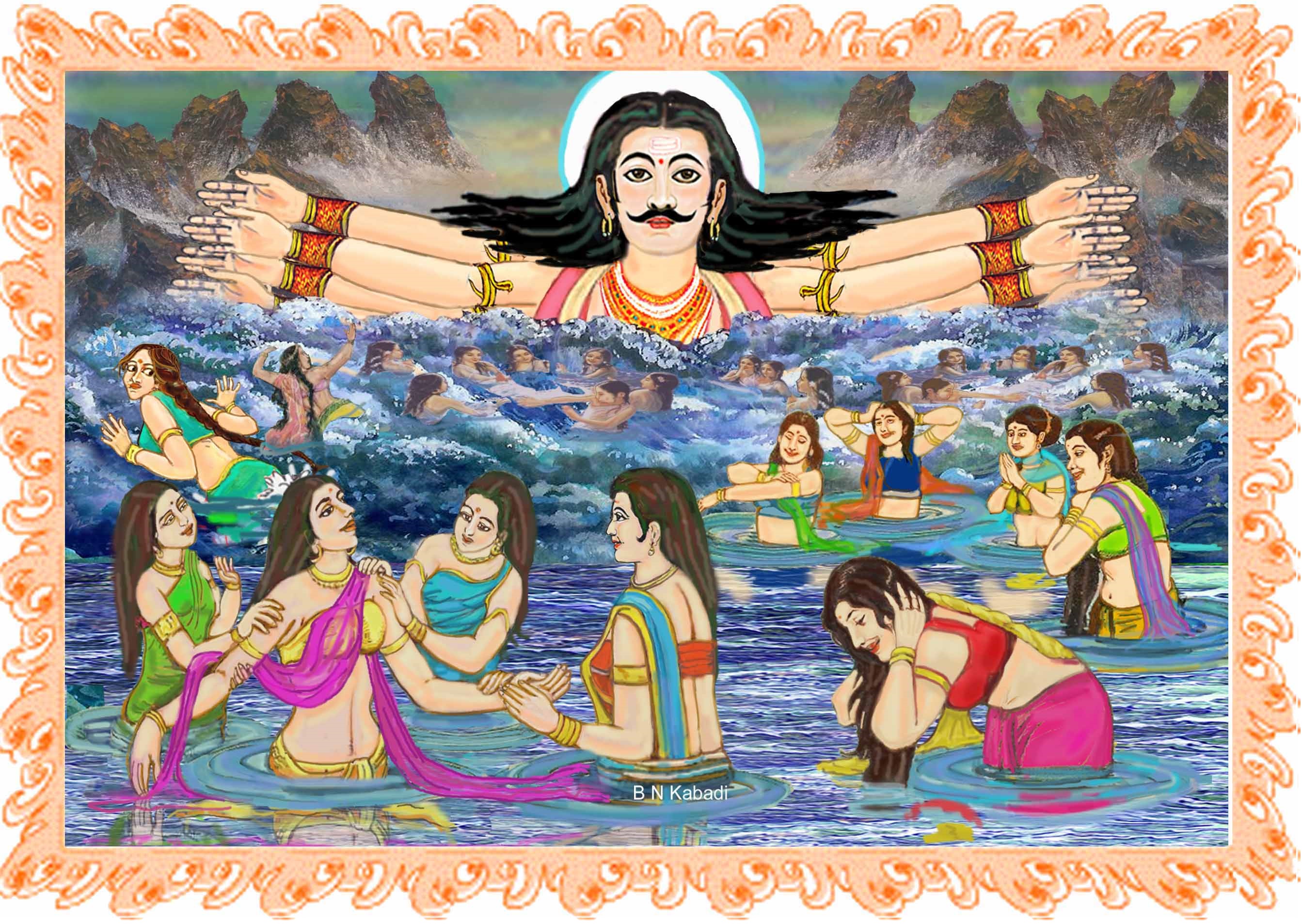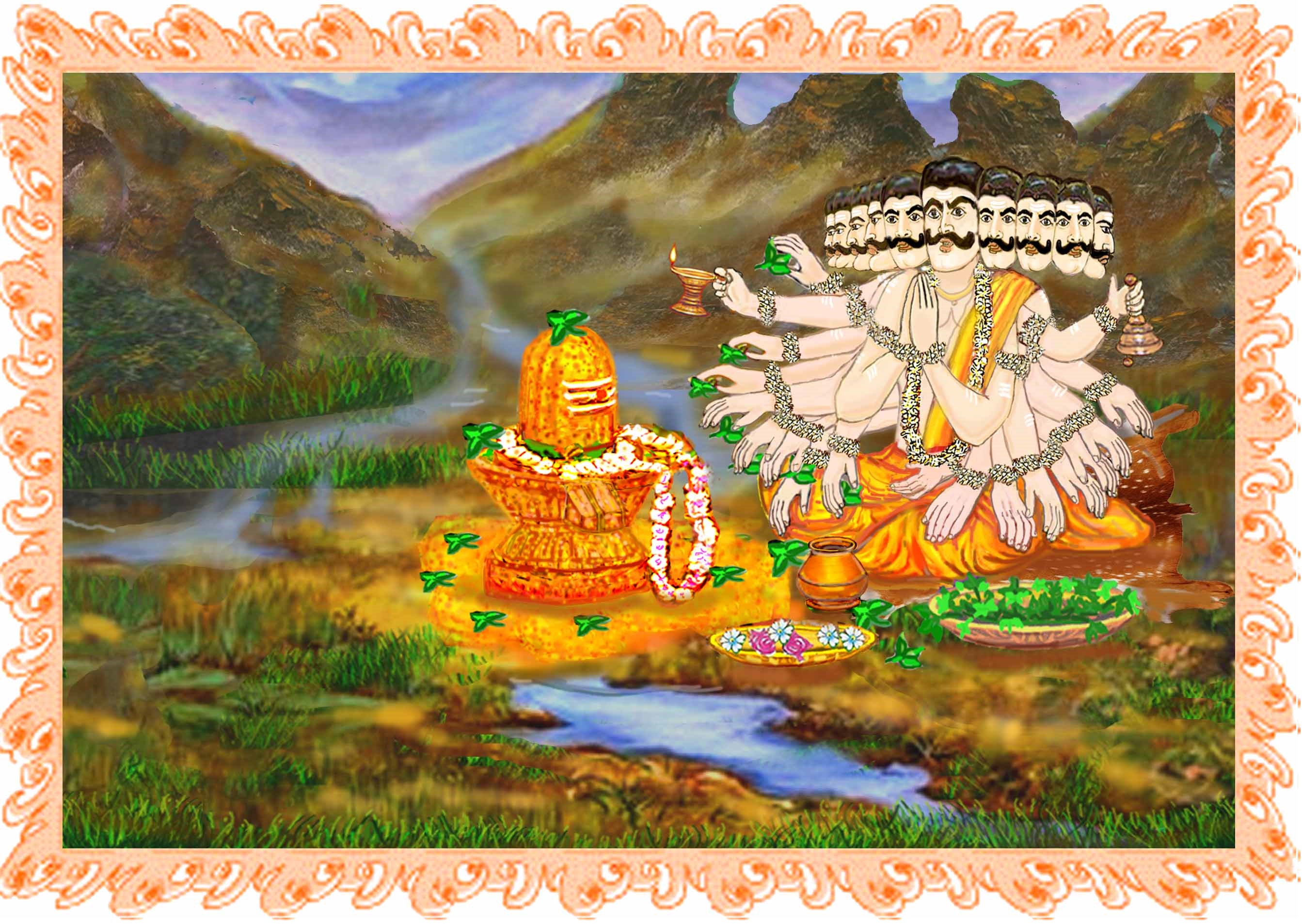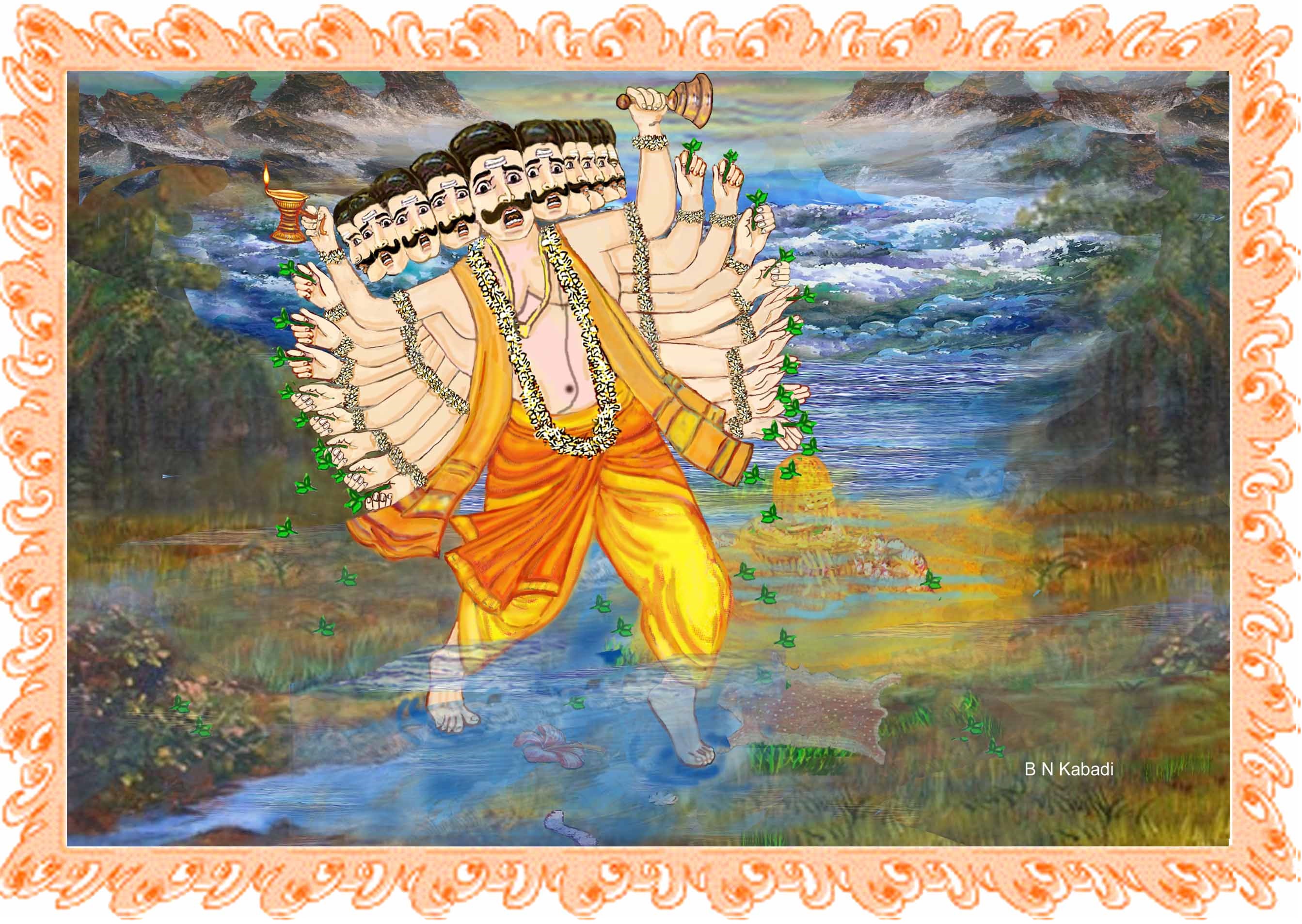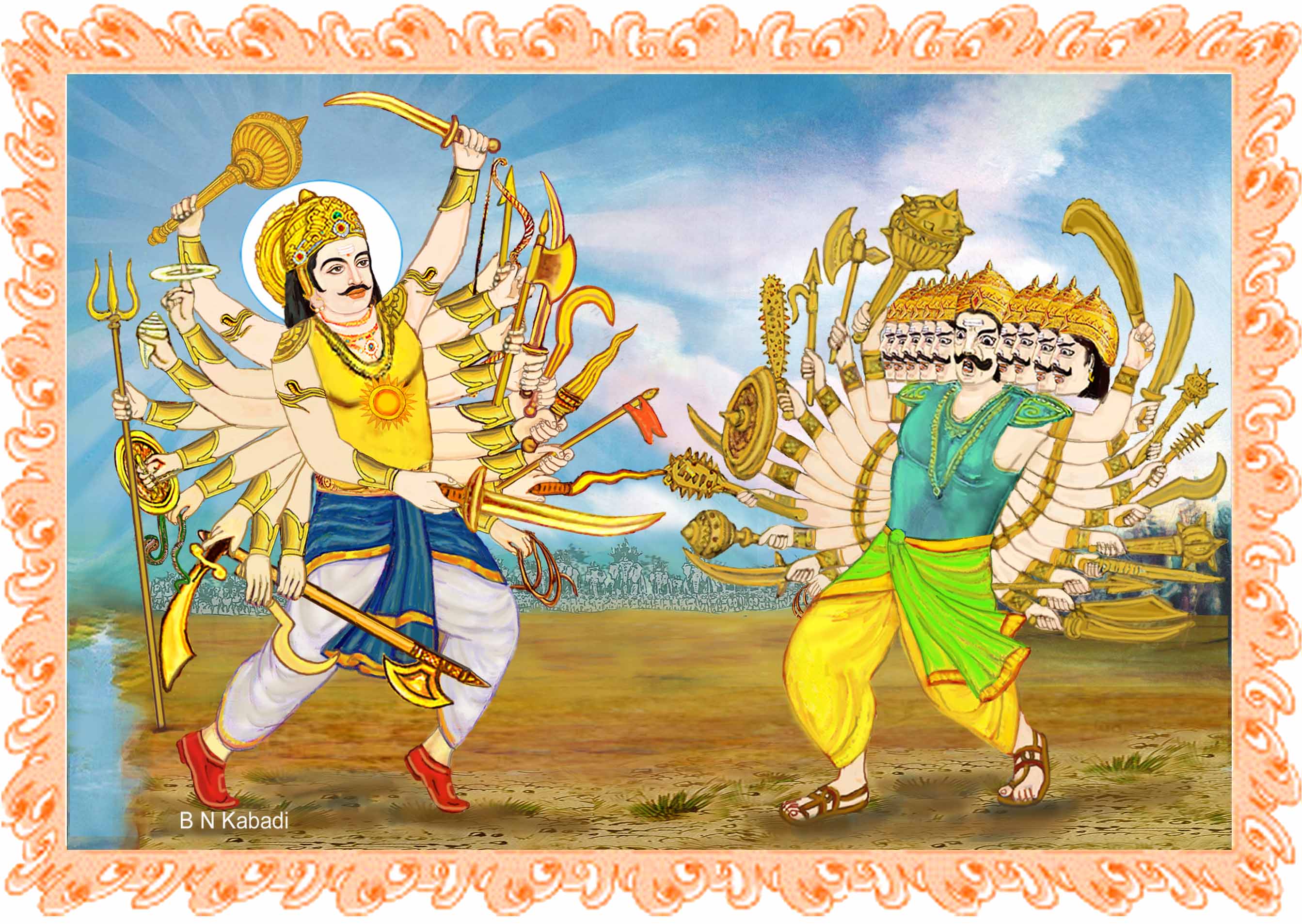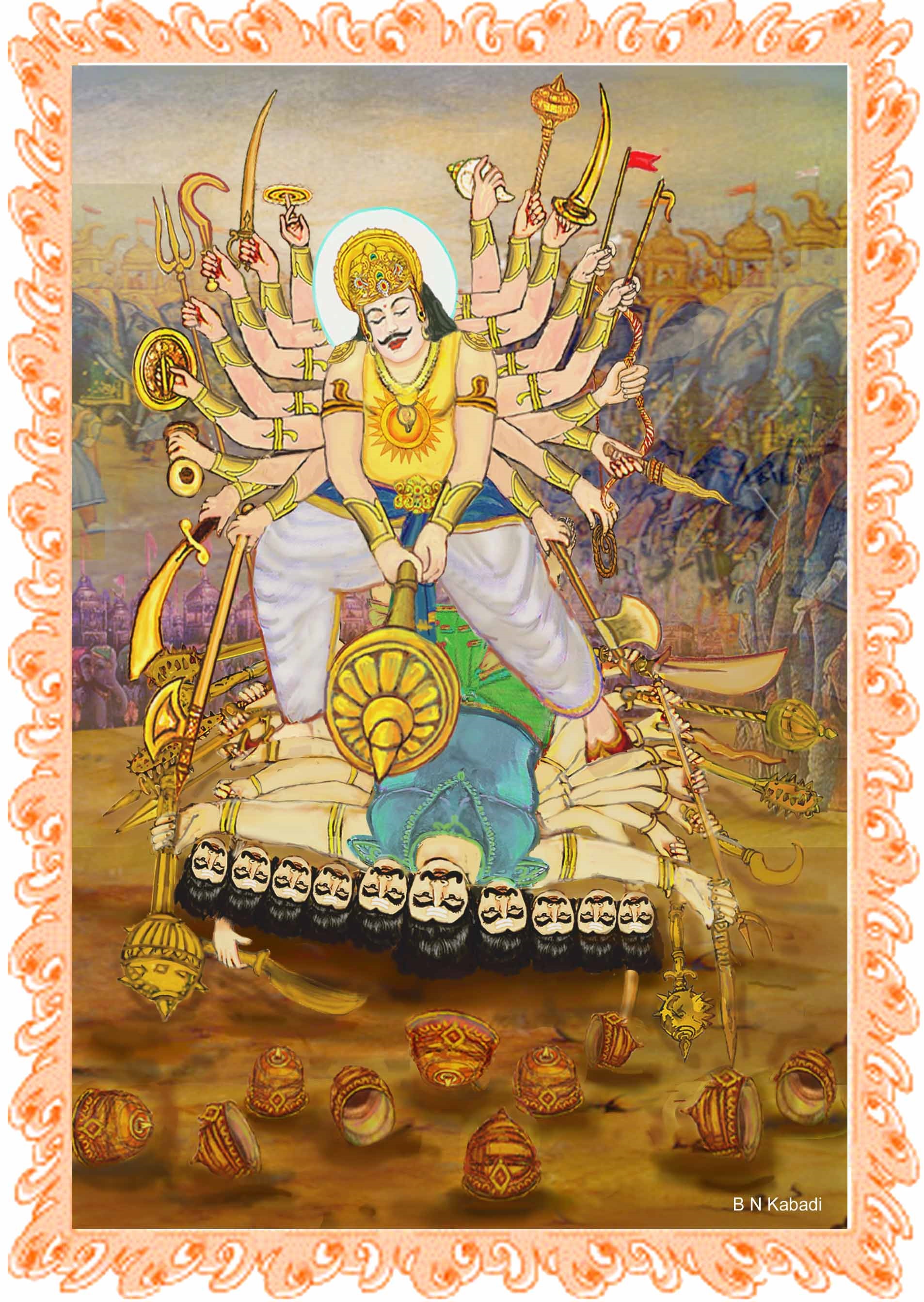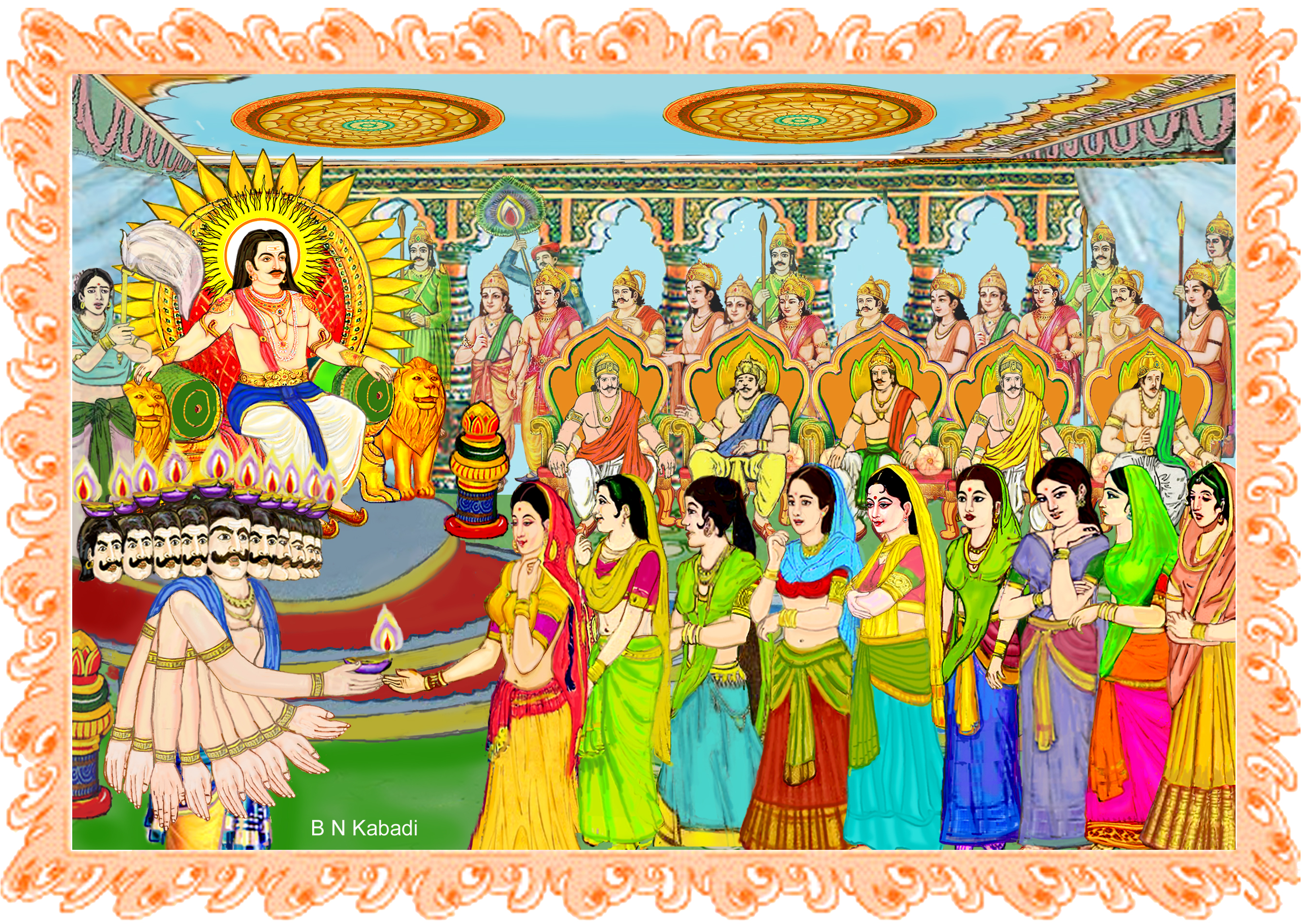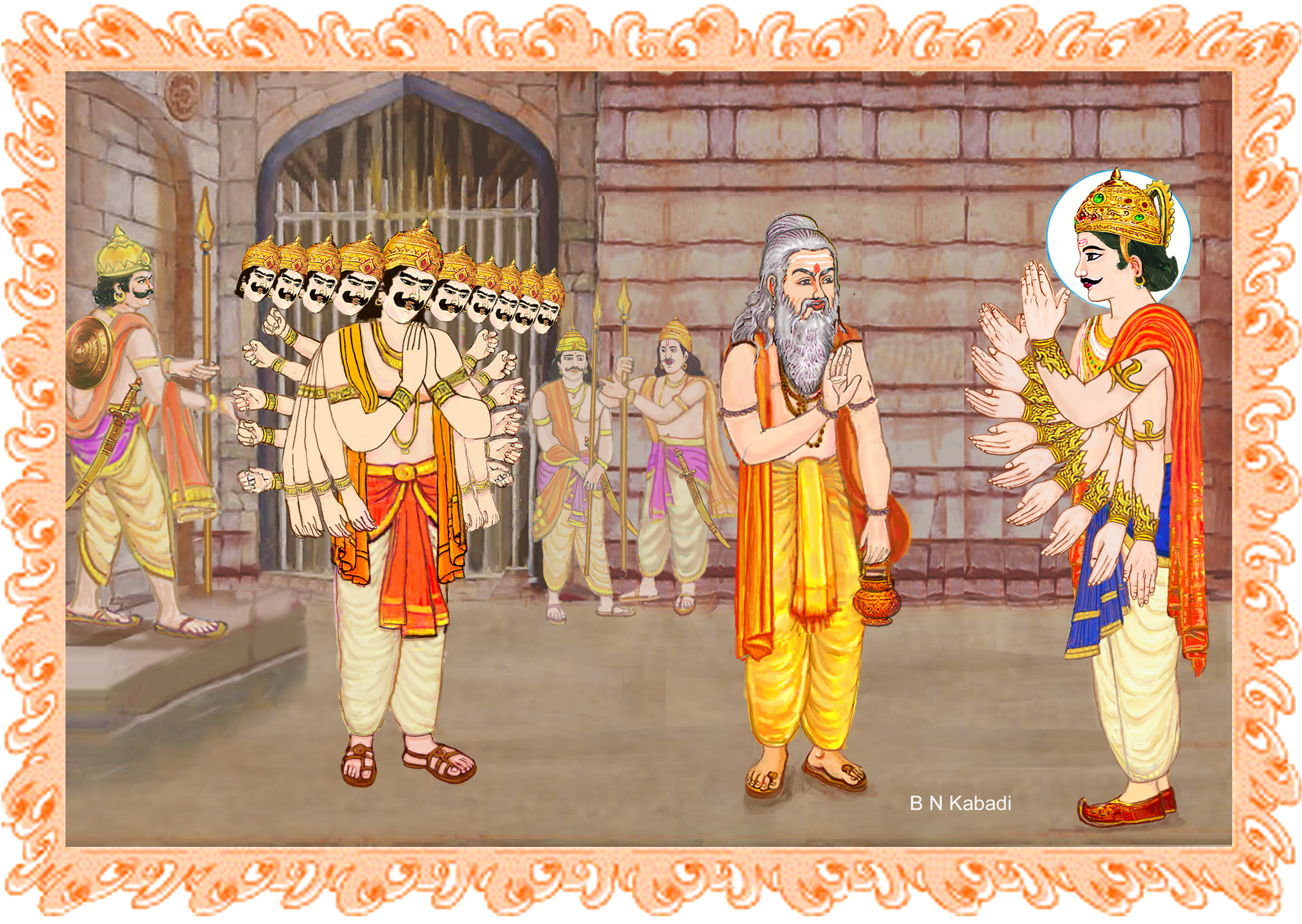Sahasrarjun was the twenty fourth avatar of Vishnu’s Chakra. He was one of the most powerful of the 14 well-known mythological emperors of ancient India. He was the son of Emperor Kritivirya and Sarama Devi (Padmini) and ruled the 7 mythological islands that comprised the known world. |
Narad muni, the universal traveler, visited Lord Vishnu, the resident of heaven, who gracefully welcomed him. Narad muni praised God Vishnu, the protector of humanity. With sincere concern, he conveyed that the earth was in turmoil. The adharmies and misfits of society were harassing, torturing, and terrorizing the innocent citizens of earth—interfering in their daily lives and worships. Narad muni earnestly beseeched God Vishnu to visit earth and destroy this evil doer and restore peace and tranquility. |
While God Vishnu was contemplating this matter, the Sudarshan Chakra adorning his right hand, addressed here as a Chakra Deva, became filled with extreme pride in his own powers—going so far as to boast that without his ability to sever the necks of demons God Vishnu would not be able to establish peace on earth. |
Shanka, who adorns God Vishnu’s left hand, addressed here as Shanka Deva, became annoyed by the comments of Chakra Deva causing an argument to ensue. In heated spirit, Shanka Deva cursed Chakra Deva—stating "you will be sent to earth to experience a lesson how to be humble." Quickly returning to his senses, Chakra Deva apologized for his prideful remarks with utmost grief. Shanka Deva informed him in the forgiving tone that Lord Vishnu, in the avatar of Parashuram, would be the one to return Chakra Deva to heaven. |
|
To curb his arrogance, it is said Lord Vishnu sent Chakra Deva to earth without upper limbs. He was born to Emperor Kritivirya and Sarama Devi as Arjun with no arms. The parents were stricken with grief after laying eyes upon their child without limbs and prayed to God Dattatreya to bless their child and correct his deformity. Common folklore in the Khanadesh area is that Kritivirya and Saramadevi prayed God Dattatreya daily at the Ganesha temple located on the great lake until, at last their prayers bore fruit and Dattatreya blessed the baby Arjun with normal hands. Kritivirya and Sarama Devi immediately became filled with joy and saw a glow in baby Arjuna’s face. |
The kingdom celebrated baby Arjuna’s birthday with great joy. Gods from heaven blessed him and showered him with flowers. As prince, Arjun had a lovely childhood showered with constant affection and adoration. His pleasant manners and natural aura attracted the attention of all. He especially enjoyed playing with bows and arrows. |
Keeping with kingly tradition of the time, Emperor Kritavirya sent teen Arjun to Sage Dattatreya's ashram to learn the Vedas and Puranas—containing the essence of Hindu religion—and train in the basic skills of war. Upon his arrival to the Ashram, he was welcomed by Guru Dattatreya’s mother, Anasuya. Young Arjun was a diligent, perceptive, and astute student—quickly absorbing the knowledge of Hindu philosophy contained within the Vedas. |
He was also quick to grasp the use of weapons mastering thousands of basic techniques and war strategies taught by Guru Dattatreya. He was very impressed with his progress and performance. |
After completing his studies and training at the Ashram, Youth Arjuna returned to Mahismati accompanied by Guru Dattatreya where they received a wholehearted welcome by Sahasrarjun’s parents. The entire kingdom celebrated the return of their prince with great festivities. Money, clothing, grains and other material gifts were widely distributed to the Brahmins and poor citizens of the kingdom. |
As Emperor Kritivirya had reached advanced age, he was advised by his ministers and supporters to retire and pass the crown to Arjuna. As such, Kritivirya ceremoniously transferred the responsibility of the kingdom to Arjuna. |
With great gaiety, Arjuna was crowned upon the throne of Kritivirya. His coronation was celebrated with great pomp through the kingdom. Arjuna desired to extend the might of his kingdom to influence all rulers of the world. Following the advice of Sage Garamuni, he went to Sahyadri Mountain for preparatory meditation and prayer. |
Arjuna prayed on the mountain to God Dattatreya with deep devotion ceaselessly for ten thousand years. |
Pleased with Arjuna’s devotion, God Dattatreya granted him an audience and blessed him with three boons and a gift. To allow him to fulfill his goal of conquering the earth, God Dattatreya blessed Ararjuna with wish of one-thousand mighty skilled hands. These hands are considered to symbolize the spokes of Vishnu’s Sudarshan Chakra in heaven. |
Empowered by his new hands, Arjuna felt extreme joy—floating and raising his hands towards heaven. He was blessed by the Gods of heaven who showered flowers upon him. |
Arjuna’s thousand powerful hands made him invincible to his enemies. Facing an enormous army on the battlefield, Arjun prayed for his boon from God Dattatreya and assumed his genie-like giant avatar form, spreading each of his thousand weapon-bearing arms. His height extended the entire distance from earth to heaven. He rejoiced by raising his thousand hands to heaven with glory as a light equivalent to one-thousand sun rays radiated from his body. The glow of his aura reached all four corners of the earth and sky, blinding his enemies and causing them to tremble and scramble. Arjun conquered all known and hitherto unknown overseas kingdoms. Henceforth, he was addressed as Sahasrarjun, Sahasrabhahu, Sahasrabhujadhari, Kritaviryanandan, Parakrami Arjun, Rajarajeshwar Kartivirya, Haihayaraja, Dashagrivajayi, Nagapal and many other wonderful titles. Like his father, he too was addressed as Maha Chakravarti, the great emperor, and ruled the earth gracefully. Sahasrarjun's devotion to God Dattatreya was eternal, and, in return, the God granted him ability the disposition power and rule the kingdom righteously perform his kingly duties, address all wrongdoing justly, and rule his kingdom with great beneficence. It was said "no other king shall ever equal Sahasrarjun in regards to sacrifices, liberality, austerities, courtesy, and self-restraint." |
God Dattatreya also blessed Sahasrarjun with the gift of a golden ratha (divine chariot) that would appear instantly upon his wish, and carry him to any place he desired. Sahasrarjun, keeping with his reputation, used his golden ratha to serve his subjects—routinely roaming the streets of Mahishmati to greet and assure his subjects, who welcomed him wholeheartedly. |
With the blessings of God Dattatreya, Sahasrarjun married Kashmira Devi in a huge gathering of kings and nobles as a grand celebration was held throughout the kingdom. In his entire lifetime, Sahasrarjun had a total of 500 wives. |
Sahasrarjun was a dedicated devotee of God Shiva and diligently performed Shiva puja daily. He was at peace as ruler, and his subjects were happy and content. |
As was his duty as a Kshatriya king, Sahasrarjun performed numerous Yagnas (sacrifices) involving ritualistic reading and chanting of religious verses and prayers in Sanskrit by priests and Brahmins while offering ghee (melted butter), milk, and other sacred items to the fire. This religious ritual, commonly referred to as sacrifice, is still is practiced today by both Kshatriyas and Brahmins throughout the world. Many believe that performing Yagnas wards off evil spirits, builds inner power, and bonds mortals to God. It is said Sahasrarjun performed one-thousand Yagnas in his lifetime. |
After each Yagna, Sahasrarjun would generously share his wealth, food, and material possessions with the Brahmins as well as the poor and needy. After each puja he even donated the solid gold Yagna frame to his subjects. "Thus Sahasrarjun ruled for 85,000 years with unbroken health, prosperity, strength, and valor". Many new advancements were made in agriculture overseas trade. |
Sahasrarjun was known for his generosity. One day, hungry Agnideva, the God of fire, approached and pleaded Sahasrarjun to permit him to satisfy his appetite. Sahasrarjun conceded the outskirt forest to Agnideva permitting him to burn it down and satisfy his hunger. However, Agnideva's insatiable appetite consumed and spread the fire from the forests to the hills and into the cities. |
Spread by the wind, Agnideva’s raging eventually reached the ashram of Sage Apava in the forest, burning it to the ground. Enraged, the Sage blamed Sahasrarjun for this mishap. In an anger he looked to the heavens and spelled aloud a curse “Ye Sahasrarjun for all the miseries you have caused on all of us, one day Parashuram will severe all your hands where your power lies.” Hence, the story of Sahasrarjun, God Vishnu’s twenty fourth Chakravatar, is directly related to the story of Parashuram, God Vishnu's sixth avatar. |
One day, while returning from the battlefield with his sons and victorious troops, Sahasrarjun came across the ashram of Sage Jamadagni in the woods. Weary from battle and stricken with thirst, he decided to stop at the ashram for rest. The sight of huge Sahasrarjun’s troops at the front door of the ashram struck fear into the hearts of the resident sages who quickly moved to flee until Sage Jamadagni recognized Sahasrarjun and kindly welcomed him and his army to his ashram. The thirsty guests immediately quenched their thirst and rested before Sage Jamadagni presented them with a lavish feast with enough food for every single person to eat to their heart’s content with the help of Kamdhenu, the mythological cow goddess of infinite strength and unending source of food. Sage Jamadagni acquired Kamadhenu as gift from God Indra, after long meditation. He had to follow certain ritualistic worship to keep contended Kamadhenu serving him. |
Sahasrarjun’s greedy sons were curious to know how it was that a small ashram could feed an entire hungry army. Once they discovered the power of Goddess Kamadhenu, they requested Jamadagni turn her over to them, to continue feeding their armies as well as their poor citizens. When the sage refused, they forcibly dragged away Kamadhenu against Jamadagni’s will. A serious struggle ensued, and in the heat of it, Sahasrarjun intervened and killed Jamadagni. Renuka to protect her husband Jamadagni from the grips of sure death also rushed in and interfered in the struggle was injured with twenty-one stab wounds. |
Jamadagni’s ill tempered Brahman son, Parashuram, soon returned from his daily chores to find the deserted ashram with his injured mother beating her chest over his father’s lifeless body. It is said she beat her chest a total of twenty-one times. In characteristic fashion, Parashuram flew into a fit of rage as he raised his axe above his head and vowed: "I will destroy all Kshatriyas from this earth for twenty-one generations." |
The irate Parashuram entered Sahasrarjun's kingdom and challenged him to a duel. Using his divine ax that never required sharpening, Parashuram arouse victorious after severing every one of Sahasrarjun’s one-thousand mighty hands before exacting his vengeance upon the sons of Sahasrarjun, ending every one of their lives. Once again limbless as he was born, Sahasrarjun returned to God Vishnu at his abode in heaven. In other puranas it is written that Sahasrarjun forcibly stole Kamadhenu from Jamadagnis ashram. Irate Parashurama challenged Sahasrarjun and killed him and brought back Kamadhenu. Sahasrarjuns sons in turn however entered the ashram of Jamadagni as a revange killed him. Irate Parashuram then destroyed Sahasrarjuns children and other Kshatriyas for 21 generations. Folklore at Maheshwar maintains that after losing his duel with Parashuram, Sahasrarjun stood in the Narmada River near the Kaleshwar temple and prayed to God Shiva. The God blessed him, and their souls merged, pronouncing "hence forth you will be remembered as Shiva and your wife as Parvati." Hence, the Kartaviryarjun temple on the banks of the Narmada River at Maheshwar is called Shivalaya and contains a Shiva Lingu. Devotees of the temple recently have erected a symbolic portable idol representing Sahasrarjun and his wife made of 7 metal elements that is also referred to by few as Shiva Parvati idol. Religious pilgrims annually parade this idol around town during Sahasrarjun’s birthday celebrations. At the Shivalaya entrance a large sign reads: "Raj Rajeshwar Kartaviryarjun." Parashuram’s maternal ancestry was Kshatriya, and his fierce personality was the result of his grandmother, Satyavati, drinking a fertility potion that would imbue one of her grandchildren with Kshatriya traits. Despite his predisposition to violence, Parashuram was born Brahman and had committed great sin by ruthlessly killing 21 generations of Kshatriya. As such, he was exiled from Sahasrarjun’s former kingdom by his fellow Brahmans who felt his sinful bloody actions had left a stain on them. Finally Parashuram surrendered Sahasrarjuns kingdom in care of Kashapa muni before he departed. Towards the end of his life, Parashuram had no country to stand on —roaming across India until he reached the south where he threw his ax into the ocean causing it to recede and created the land that is present-day Konkan. He was eventually humbled further when he encountered Kshatriya king Ram, avatar of Vishnu, who, in a contest, broke Parashuram’s bow that had been gifted to him by God Shiva. |
As part of her daily routine, Renuka, the wife of Jamadagni and sister of Sukruti (Sahasrarjun’s wife), would bathe in the Malaprabha river each morning before returning to ashram with a pot of water for Jamagdani’s daily puja. One such morning, a joyful noise caught her attention as she walked to the river. Deciding to investigate further, she was captivated by what she found—the celestial creatures, Gandharvas and Apsaras, in fine clothing and adorned with celestial jewels, were playing by the river. The sight of these creatures caused Renuka, once a princess herself, to reflect on her ascetic lifestyle and felt a little desire to join in their pageantry. |
Distracted by this desire, Renuka’s was unable to concentrate as she attempted to form a vessel out of sand-mud to carry the water for Jamadagni’s daily puja as she did every day. Her vessel repeatedly failed to form, crumbled into pieces, and disappeared before her eyes. Scared, confused, and ashamed, shaky Renuka had no choice but to return to the Ashram empty-handed. |
Through his great spiritual power, waiting for water Jamadagni learned of Renuka’s thoughts of passionate desire and became enraged as such thoughts did not befit the ascetic life. To punish her, the sage ordered his three sons nearby to sever their mother’s head. Unwilling to obey such a heinous command yet fearful of their father’s anger, his sons attempted to flee, however before they could escape, Jamadagni’s anger burned them all to ashes. Parashuram, who had been completing his chores in the forest, returned to the Ashram after a short while and was ordered by Jamadagni to sever his mother’s head. Scared for her life after hearing the sage’s command to their sons earlier, Renuka had fled the ashram to hide within the hut of a prostitute. The dutiful Parashuram soon tracked his mother down and severed the head of the prostitute who intervened before severing his mother’s. |
One fine morning princess Satyavati was passing through the backwoods of her father’s kingdom when she came across sage Richika picking flowers off the trees for his daily puja. Richika happened to look up at Satyavati carrier, as she glanced towards him and their eyes met. Richika immediately fell in love with her beauty and decided he would marry her. The sage approached Satyavati’s father, King Gadhi, and expressed his desire to marry his daughter. |
Fearful of bad repercussions from outright rejecting the powerful sage, King Gadhi instead offered him an impossible task—demanding one-thousand horses, each as brilliant white as sunshine and with black ears. Sage Richika prayed to Varuna the God of oceans to fulfill his wish and saw one-thousand bright white horses with black ears emerge from the ocean waters before his eyes. Richika presented the horses to King Gadhi. Who was surprised the sage had fulfilled his demand, but kept his promise and offered Sage Richika the hand of his daughter Satyavati. The couple were wed before returning to Richika’s ashram in the woods. |
One day, Satyavati approached Richika and expressed her desires to have both a son and brother. Honoring her wish Richika performed yagna and presented her with two containers of Charu (blessed potions)—one for her to consume and the other for her mother. A mixture of milk rice and ghee, Charu is a typical offering to a sacred fire during yagnas. Richika informed his wife that her potion would yield its drinker a son with Brahminic qualities, whereas her mother’s would produce a son with Kshatriya traits. Suspicious by nature, Satyavati’s mother presumed Sage Richika had reserved the better potion for his wife and secretly switched potions with her daughters. Both mother and daughter consumed the Charu and became pregnant with the child intended for the other. Richika eventually felt something was wrong and through his divine powers realized what Satyavati’s mother had done. After learning the truth, Satyavati became upset as she feared having a son who would ruthlessly kill. She wanted a sage-like Brahmin child and beseeched Richika to intervene. The sage offered her the option of the Kshatriya traits destined for her child to skip a generation and affect one of her grandchildren instead. She accepted. “This resulted in Satyavati's mother giving birth to Vishwamitra, the son of a Kshatriya King Gadhi with the qualities of a Brahmin. Satyavati gave birth to a Brahmin son Jamadagni, the father of Parashurama, a Brahmin who had characteristics of a Kshatriya.” |
Ravana’s encounter -Story of Sahasrarjun and Eleven lights: Around Mahishmati, there is a common folklore of Sahasrarjun defeating Ravana. Across the river Narmada from Kartaviryarjun Shivalaya , there is a broken landmark standing on the top of the hills where Ravana was imprisoned. |
|
|
During the merrymaking between Sahasrarjun and his wives, Ravana had unknowingly chosen a dry shore of the Narmada river downstream from them to perform Shivaling puja. Having built a Shivaling from wet sand with puja materials arranged around it, he was well into performing the puja. |
After Sahasrarjun's wives completed their water entertainment and left the waters to change clothes, Sahasrarjun lifted his thousand shoulders from the river, dislodging the backed up river waters, which now forcefully gushed downstream and flooded the area where Ravana was performing puja. This disrupted puja by floating and washing away the puja materials. Furious at this interception, Ravana loudly roared that whomever was responsible for disrupting the puja would be severely punished. His roar could be heard everywhere and caused all to tremble. |
After discovering the culprit, Ravana, with his ten heads and twenty fully-armed hands as well as his mighty rakshasa army behind him, challenged Sahasrarjun to a duel. |
To his amazement, Ravana was unable to overcome the strength of Sahasrarjun’s one-thousand arms and was easily defeated. Mighty Sahasrarjun pinned him down and tied his hands with his pasha (cord) before dragging him to his kingdom and imprisoning him. |
To humble the rakshasa-king, Sahasrarjun made Ravana stand at his Darbar and hold a ghee lamp in his hand and ten on each of his heads. Furthering his humiliation, Sahasrarjun’s wives placed these eleven ghee lamps one lamp in Ravanas hand and upon each of his ten heads while standing in an open Darbar. |
Ravana’s grandfather, Pulastya, eventually pleaded with Sahasrarjun to release his grandson. Satisfied Ravana had learned a good lesson, Sahasrarjun agreed to release him to Pulastaya and bestowed many gifts upon them before sending them home to Lanka. To commemorate this event, devotees of the Sahasrarjun temple at Maheshwar keep 11 lit lamps filled with ghee at all times so they never cease burning. Much of the ghee they use comes from offerings made by temple patrons. Every SSK person should undertake a pilgrimage to this most sacred Sahasrarjun temple and witness at least once in their lifetime and let themselves become inspired by the continuously burning lamps that commemorate Ravana’s defeat and celebrate our proud Kshatriya heritage. Jaya Sahasrarjun. |
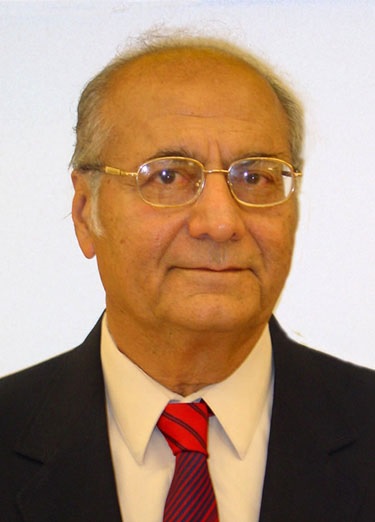 Author: B N Kabadi PH D. was the Founder and first President of Somavaunshya Sahasrarjun Kshatriya Samaj of North America (SSKNA). He is the author and publisher of the book "The Illustrated Story of Sahasrarjun" which has been printed in English, Kannada, and Hindi editions, as well as a Telugu version recently published by the Hyderabad SSK. He has written few other books and published many articles on Sahasrarjun and SSK heritage in English and Kannada in India. He has written many articles on Sahasrarjun and SSK heritage on our web site SSKNA.org. The author thanks to Mr Ashok Kabadi , Dr Rajiv Kabadi, Mrs Nirmala Miskin,and Mr Pentosha Golconda for their valuable input and comments. |

